Paul van Yperen's Blog, page 386
April 10, 2015
Scampolo (1958)
Romy Schneider (1938-1982) was one of the most beautiful and intelligent actors of her generation. After the enormously successful Sissi trilogy she soon became nauseated by the saccharine ‘nice girl’ image. At the end of the 1950s, Romy appeared in a bit less stereotypical films such as the sunny comedy Scampolo (1958).
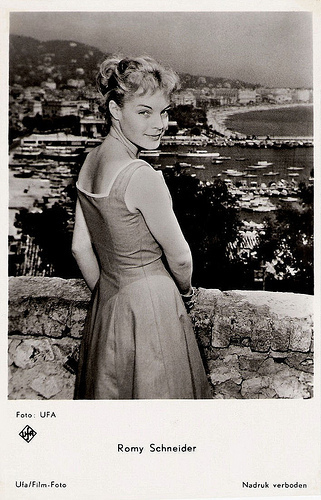
Dutch postcard by Gebr. Spanjersberg N.V., Rotterdam, no. 3651. Photo: Ufa, Berlin. Publicity still for Scampolo (1958).
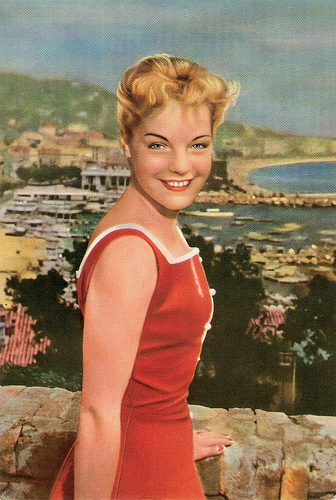
Dutch postcard by Gebr. Spanjersberg, no. 1014, mailed in 1958. Photo: Universum-Film Aktiengesellschaft (UFA), Berlin-Tempelhof.
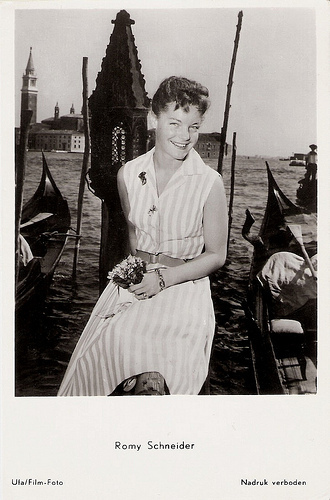
Dutch postcard by Gebr. Spanjersberg N.V., Rotterdam, no. 1040/858. Photo: Universum-Film Aktiengesellschaft (UFA), Berlin-Tempelhof.
Scampolo
In the German production Scampolo (Alfred Weidenmann, 1958), Romy starred as a young, poor orphan who lives on the Italian island Ischia. Scampolo works as a tourist guide and for a laundress (Elisabeth Flickenschildt). She falls in love with a handsome but poor architect ( Paul Hubschmid ) who hopes to win a design competition. Scampolo intercedes on his behalf with the minister ( Viktor de Kowa ) and helps him to make his dream come true.
Scampolo (translation: remnant) was loosely based on a play by Dario Niccodemi. It was not the first film adaptation. In 1917 there was already an Italian silent film directed by Giuseppe Sterni with Margot Pellegrinetti as Scampolo.
Silent film diva Carmen Boni played her also in a 1928 Italian production directed by Augusto Genina. This version has been recently rediscovered and restored by the Bologna cinematheque.
Four years later Hans Steinhoff made a sound version in Germany starring Dolly Haas , Scampolo, ein Kind der Straße/Scampolo a Child of the Streets (1932). This time Scampolo has nowhere to live in Berlin, and must sleep rough. Steinhoff also directed a French language version, Un peu d'amour/A Bit of Love (1932), starring Madeleine Ozeray .
In 1941 followed another Italian version, Scampolo (Nunzio Malasomma, 1941) with Lilia Silvi and in 1953 yet a new Italian adaptation Scampolo 53 (Girogio Bianchi, 1953) starring Maria Fiori. The 1958 version with Romy Schneider was the last film adaptation, till now.
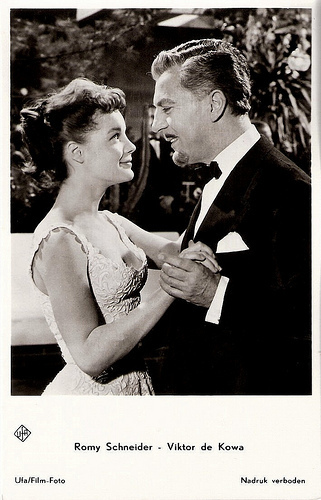
Romy Schneider and Viktor de Kowa . Dutch postcard by Gebr. Spanjersberg N.V., Rotterdam, no. 1108. Photo: UFA (Universum-Film Aktien-gesellschaft, Berlin-Tempelhof). Still from Scampolo (1958).
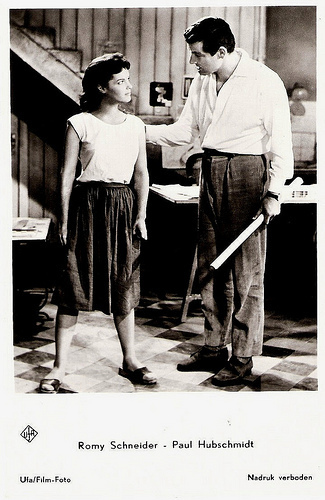
Romy Schneider and Paul Hubschmid . Dutch postcard by Gebr. Spanjersberg N.V., Rotterdam, no. 1118. Photo: UFA (Universum-Film Aktien-gesellschaft, Berlin-Tempelhof). Publicity still for Scampolo (Alfred Weidenmann, 1958).
Talented at multiple levels
Scampolo was only the second film young idol Romy Schneider made after the hugely popular Sissi trilogy.
The cast included well-known actors as Paul Hubschmid , Georg Thomalla , Eva Maria Meineke, Franca Parisi , Elisabeth Flickenschildt, Willy Millowitsch, Walter Rilla and Viktor de Kowa , but Schneider was the heart of the film.
Marcin Kukuczka at IMDb : " Romy Schneider is great! The fact that Scampolo was filmed just after the third part of Sissi is too significant not to be skipped. Romy was considered to fit best to 'royal roles' by a number of people. Partly, thanks to Scampolo, she proved that she was talented at multiple levels."
The comedy was shot on Ischia Island in Italy with wonderful cinematography by Bruno Mondi, who had also shot the Sissi films. Mondi had already started in the silent era as a camera assistant for Fritz Lang's Der Müde Tod (1921). During World War II, he worked with director Veit Harlan on the anti-Semitic propaganda film Jud Süß (1940). After the war, Mondi went on working at films without any problems and shot socialist-style re-education films in the Soviet zone like Wozzeck (Georg C. Klaren, 1947) and Rotation (Wolfgang Staudte, 1949).
StateofThings at IMDb : "Bruno Mondi is a luminous example for a brilliant and inventive cameraman and a frightening example for a perfect technician, not asking for the aim of his work."
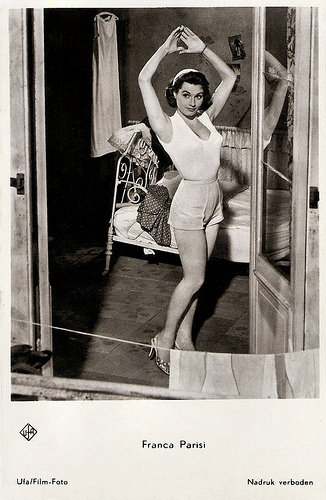
Franca Parisi . Dutch postcard by Gebr. Spanjersberg, Rotterdam (Dutch licency holder for Universum-Film Aktien-gesellschaft, Berlin-Tempelhof), no. 1086. Photo: Ufa/Film-Foto. Publicity still for Scampolo (Alfred Weidenmann, 1958).
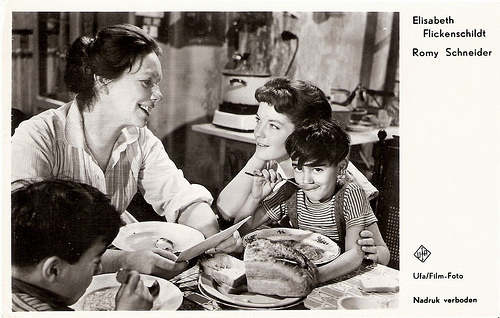
Elisabeth Flickenschildt and Romy Schneider . Dutch postcard by Gebr. Spanjersberg N.V., Rotterdam. Photo: Ufa/Film-Foto for Scampolo (Alfred Weidenmann, 1958).
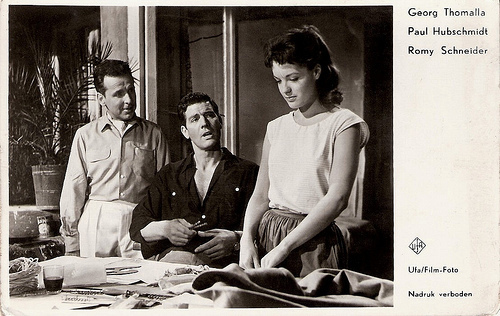
Paul Hubschmidt , Georg Thomalla and Romy Schneider . Dutch Postcard by Gebr. Spanjersberg N.V., Rotterdam. Photo: Ufa/Film-Foto for Scampolo (Alfred Weidenmann, 1958).
Source: James Travers (French Film Site), Filmreference.com, Wikipedia (English and German) and IMDb.

Dutch postcard by Gebr. Spanjersberg N.V., Rotterdam, no. 3651. Photo: Ufa, Berlin. Publicity still for Scampolo (1958).

Dutch postcard by Gebr. Spanjersberg, no. 1014, mailed in 1958. Photo: Universum-Film Aktiengesellschaft (UFA), Berlin-Tempelhof.

Dutch postcard by Gebr. Spanjersberg N.V., Rotterdam, no. 1040/858. Photo: Universum-Film Aktiengesellschaft (UFA), Berlin-Tempelhof.
Scampolo
In the German production Scampolo (Alfred Weidenmann, 1958), Romy starred as a young, poor orphan who lives on the Italian island Ischia. Scampolo works as a tourist guide and for a laundress (Elisabeth Flickenschildt). She falls in love with a handsome but poor architect ( Paul Hubschmid ) who hopes to win a design competition. Scampolo intercedes on his behalf with the minister ( Viktor de Kowa ) and helps him to make his dream come true.
Scampolo (translation: remnant) was loosely based on a play by Dario Niccodemi. It was not the first film adaptation. In 1917 there was already an Italian silent film directed by Giuseppe Sterni with Margot Pellegrinetti as Scampolo.
Silent film diva Carmen Boni played her also in a 1928 Italian production directed by Augusto Genina. This version has been recently rediscovered and restored by the Bologna cinematheque.
Four years later Hans Steinhoff made a sound version in Germany starring Dolly Haas , Scampolo, ein Kind der Straße/Scampolo a Child of the Streets (1932). This time Scampolo has nowhere to live in Berlin, and must sleep rough. Steinhoff also directed a French language version, Un peu d'amour/A Bit of Love (1932), starring Madeleine Ozeray .
In 1941 followed another Italian version, Scampolo (Nunzio Malasomma, 1941) with Lilia Silvi and in 1953 yet a new Italian adaptation Scampolo 53 (Girogio Bianchi, 1953) starring Maria Fiori. The 1958 version with Romy Schneider was the last film adaptation, till now.

Romy Schneider and Viktor de Kowa . Dutch postcard by Gebr. Spanjersberg N.V., Rotterdam, no. 1108. Photo: UFA (Universum-Film Aktien-gesellschaft, Berlin-Tempelhof). Still from Scampolo (1958).

Romy Schneider and Paul Hubschmid . Dutch postcard by Gebr. Spanjersberg N.V., Rotterdam, no. 1118. Photo: UFA (Universum-Film Aktien-gesellschaft, Berlin-Tempelhof). Publicity still for Scampolo (Alfred Weidenmann, 1958).
Talented at multiple levels
Scampolo was only the second film young idol Romy Schneider made after the hugely popular Sissi trilogy.
The cast included well-known actors as Paul Hubschmid , Georg Thomalla , Eva Maria Meineke, Franca Parisi , Elisabeth Flickenschildt, Willy Millowitsch, Walter Rilla and Viktor de Kowa , but Schneider was the heart of the film.
Marcin Kukuczka at IMDb : " Romy Schneider is great! The fact that Scampolo was filmed just after the third part of Sissi is too significant not to be skipped. Romy was considered to fit best to 'royal roles' by a number of people. Partly, thanks to Scampolo, she proved that she was talented at multiple levels."
The comedy was shot on Ischia Island in Italy with wonderful cinematography by Bruno Mondi, who had also shot the Sissi films. Mondi had already started in the silent era as a camera assistant for Fritz Lang's Der Müde Tod (1921). During World War II, he worked with director Veit Harlan on the anti-Semitic propaganda film Jud Süß (1940). After the war, Mondi went on working at films without any problems and shot socialist-style re-education films in the Soviet zone like Wozzeck (Georg C. Klaren, 1947) and Rotation (Wolfgang Staudte, 1949).
StateofThings at IMDb : "Bruno Mondi is a luminous example for a brilliant and inventive cameraman and a frightening example for a perfect technician, not asking for the aim of his work."

Franca Parisi . Dutch postcard by Gebr. Spanjersberg, Rotterdam (Dutch licency holder for Universum-Film Aktien-gesellschaft, Berlin-Tempelhof), no. 1086. Photo: Ufa/Film-Foto. Publicity still for Scampolo (Alfred Weidenmann, 1958).

Elisabeth Flickenschildt and Romy Schneider . Dutch postcard by Gebr. Spanjersberg N.V., Rotterdam. Photo: Ufa/Film-Foto for Scampolo (Alfred Weidenmann, 1958).

Paul Hubschmidt , Georg Thomalla and Romy Schneider . Dutch Postcard by Gebr. Spanjersberg N.V., Rotterdam. Photo: Ufa/Film-Foto for Scampolo (Alfred Weidenmann, 1958).
Source: James Travers (French Film Site), Filmreference.com, Wikipedia (English and German) and IMDb.
Published on April 10, 2015 22:00
April 9, 2015
Elisabeth Wiener
Elisabeth Wiener (1946) is a French actress, singer, songwriter and performer, who appeared in several French and Italian films of the 1960s and 1970s.
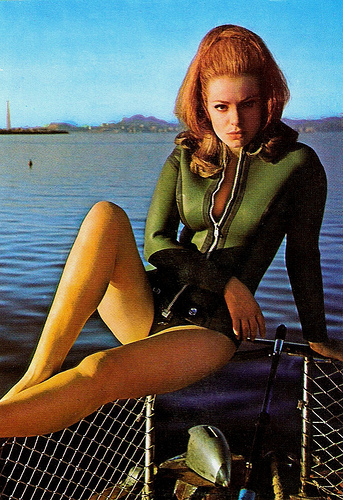
Romanian postcard by Casa Filmului Acin.
Sensational Erotic and Psychological Thriller
Elisabeth (or Élizabeth) Wiener was born in Paris, France in 1946 as the daughter of composer Jean Wiener and film editor Suzanne De Troeye. She began her acting career at the age of 15 and also practiced classical singing and piano.
She made her film debut as Frederique in the independent comedy Dragées au poivre/Sweet and Sour (Jacques Baratier) with Guy Bedos. Soon followed L'Année du bac/Graduation Year (Maurice Delbez, José-André Lacour, 1964) with Jean Desailly. She also had a small part in the American war drama Behold a Pale Horse (Fred Zinnemann, 1964) starring Gregory Peck, which was filmed in France.
At 16 and a half she married. Two years later, she played Coralie, a young stage actress, in the TV mini-series Illusions perdues/Lost Illusions (Maurice Cazeneuve, 1966), based on a novel by Honoré de Balzac. At the time she appeared in many French TV films and series, including the popular mini-series Jacquou le Croquant/Jacquou the crunch (Stellio Lorenzi, 1969).
In the cinema she participated in the crime film Johnny Banco (Yves Allégret, 1967), a disastrous euro pudding with both funds and stars (including Horst Buchholz and Sylva Koscina ) from three European countries.
More interesting was the sensational erotic and psychological thriller La Prisonnière/The Female Prisoner (Henri-Georges Clouzot, 1968) in which she starred as the emotional prisoner of voyeur Laurent Terzieff . It was the last film of Henri-Georges Clouzot, the French Alfred Hitchcock.
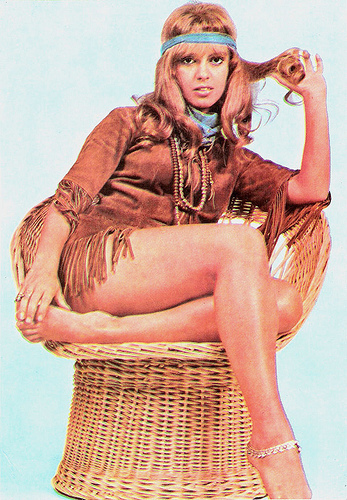
Romanian postcard by Casa Filmului Acin.
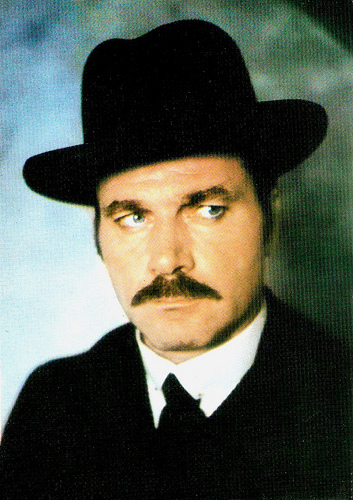
Franco Nero . Romanian postcard by Casa Filmului Acin.
A Mythical War Between Goddesses
During the early 1970s, Elisabeth Wiener acted in such films as On est toujours trop bon avec les femmes/One Is Always Too Good to Women (Michel Boisrond, 1971), Le moine/The Monk (Adonis Kyrou, 1972) with Franco Nero , the comedy Trop jolies pour être honnêtes/Too Pretty to Be Honest (Richard Balducci, 1972) with Jane Birkin , and La Jeune Fille assassinée/The Assassinated Young Girl (Roger Vadim, 1974).
One of her most interesting films was Duelle/Duel (Jacques Rivette, 1976) starring Juliet Berto and Bulle Ogier. It was meant to be as the first of four different films directed by Jacques Rivette with a running sub-plot involving a mythical war between goddesses of the Sun and the Moon, but till now Rivette has made only three parts.
In Italy, Wiener appeared in Al di là del bene e del male/Beyond Good and Evil (Liliana Cavani, 1977) starring Dominique Sanda , and the comedy Bianco, rosso e Verdone/White, red and Verdone (Carlo Verdone, 1981).
Wiener participated in musical performances by Michel Polnareff and Jacques Higelin. Most notably, she collaborated on their album Champagne pour tout le monde (Champagne for everyone). She is also interested in jazz as well as in contemporary and ethnic music. She joined such alternative rock groups as Phoenix before she started a solo career. She wrote for many singers and also composed several film scores. In 1992 she founded the female band Castafiore Bazooka.
Her most recent screen appearance was in the TV series Les Misérables (Josée Dayan, 2000) starring Gérard Depardieu . Elisabeth Wiener currently works as a voice actor and dubs such American stars as Jamie Lee Curtis, Glenn Close, Mia Farrow, Meryl Streep and Lauren Holly in the popular crime series NCIS (2005-2008). And she performs and records as La Beth and with her band Castafiore Bazooka.
Original French trailer of La Prisonnière/The Female Prisoner (1968). Source: Vincent Domaslaw (YouTube).
Elisabeth Wiener sings Vie a vies (1982). Source: TchikiSteph (YouTube).
Sources: ElisabethWiener.com (French), Wikipedia (French and English) and .

Romanian postcard by Casa Filmului Acin.
Sensational Erotic and Psychological Thriller
Elisabeth (or Élizabeth) Wiener was born in Paris, France in 1946 as the daughter of composer Jean Wiener and film editor Suzanne De Troeye. She began her acting career at the age of 15 and also practiced classical singing and piano.
She made her film debut as Frederique in the independent comedy Dragées au poivre/Sweet and Sour (Jacques Baratier) with Guy Bedos. Soon followed L'Année du bac/Graduation Year (Maurice Delbez, José-André Lacour, 1964) with Jean Desailly. She also had a small part in the American war drama Behold a Pale Horse (Fred Zinnemann, 1964) starring Gregory Peck, which was filmed in France.
At 16 and a half she married. Two years later, she played Coralie, a young stage actress, in the TV mini-series Illusions perdues/Lost Illusions (Maurice Cazeneuve, 1966), based on a novel by Honoré de Balzac. At the time she appeared in many French TV films and series, including the popular mini-series Jacquou le Croquant/Jacquou the crunch (Stellio Lorenzi, 1969).
In the cinema she participated in the crime film Johnny Banco (Yves Allégret, 1967), a disastrous euro pudding with both funds and stars (including Horst Buchholz and Sylva Koscina ) from three European countries.
More interesting was the sensational erotic and psychological thriller La Prisonnière/The Female Prisoner (Henri-Georges Clouzot, 1968) in which she starred as the emotional prisoner of voyeur Laurent Terzieff . It was the last film of Henri-Georges Clouzot, the French Alfred Hitchcock.

Romanian postcard by Casa Filmului Acin.

Franco Nero . Romanian postcard by Casa Filmului Acin.
A Mythical War Between Goddesses
During the early 1970s, Elisabeth Wiener acted in such films as On est toujours trop bon avec les femmes/One Is Always Too Good to Women (Michel Boisrond, 1971), Le moine/The Monk (Adonis Kyrou, 1972) with Franco Nero , the comedy Trop jolies pour être honnêtes/Too Pretty to Be Honest (Richard Balducci, 1972) with Jane Birkin , and La Jeune Fille assassinée/The Assassinated Young Girl (Roger Vadim, 1974).
One of her most interesting films was Duelle/Duel (Jacques Rivette, 1976) starring Juliet Berto and Bulle Ogier. It was meant to be as the first of four different films directed by Jacques Rivette with a running sub-plot involving a mythical war between goddesses of the Sun and the Moon, but till now Rivette has made only three parts.
In Italy, Wiener appeared in Al di là del bene e del male/Beyond Good and Evil (Liliana Cavani, 1977) starring Dominique Sanda , and the comedy Bianco, rosso e Verdone/White, red and Verdone (Carlo Verdone, 1981).
Wiener participated in musical performances by Michel Polnareff and Jacques Higelin. Most notably, she collaborated on their album Champagne pour tout le monde (Champagne for everyone). She is also interested in jazz as well as in contemporary and ethnic music. She joined such alternative rock groups as Phoenix before she started a solo career. She wrote for many singers and also composed several film scores. In 1992 she founded the female band Castafiore Bazooka.
Her most recent screen appearance was in the TV series Les Misérables (Josée Dayan, 2000) starring Gérard Depardieu . Elisabeth Wiener currently works as a voice actor and dubs such American stars as Jamie Lee Curtis, Glenn Close, Mia Farrow, Meryl Streep and Lauren Holly in the popular crime series NCIS (2005-2008). And she performs and records as La Beth and with her band Castafiore Bazooka.
Original French trailer of La Prisonnière/The Female Prisoner (1968). Source: Vincent Domaslaw (YouTube).
Elisabeth Wiener sings Vie a vies (1982). Source: TchikiSteph (YouTube).
Sources: ElisabethWiener.com (French), Wikipedia (French and English) and .
Published on April 09, 2015 22:00
April 8, 2015
Greer Garson
British-born actress Greer Garson (1904-1996) was a very popular Hollywood star during World War II. She epitomized a noble, wise and courageous wife in sleek and sentimental films, often with Walter Pidgeon as her co-star. As one of MGM's major stars of the 1940s, Garson received seven Academy Award nominations. She won the Oscar for Mrs. Miniver (1942), in which she personified the spirit and virtue of a British homemaker in wartime.
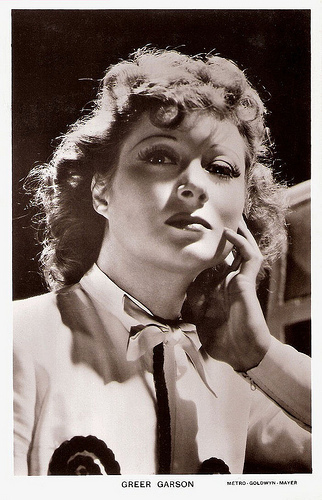
British postcard in the Picturegoer series, London, no. W 95. Photo: Metro Goldwyn Mayer (MGM).
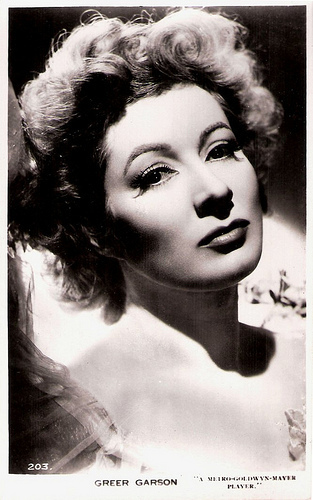
British postcard in the Real Photograph series, no. 203. Photo: MGM.
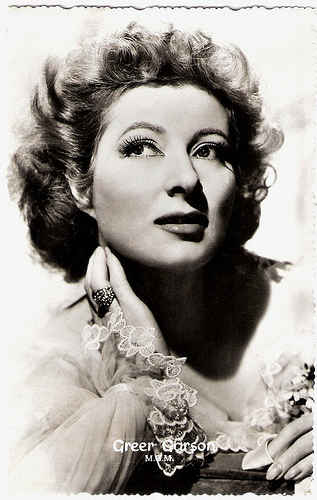
Dutch postcard by Weenenk & Snel, Baarn, no. 1155. Photo: MGM.
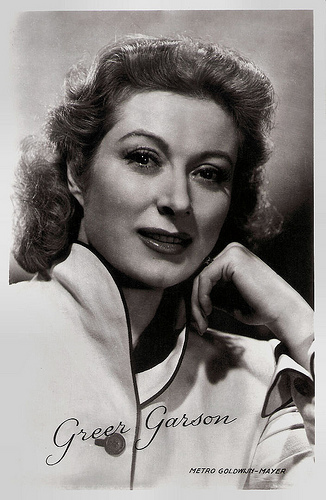
Dutch postcard, no. 3016. Photo: Metro Goldwyn Mayer (MGM).
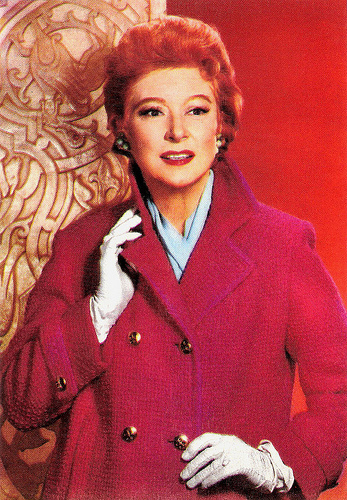
Italian postcard. Photo: Metro Goldwyn Mayer (MGM). Publicity still for The Singing Nun/Dominique (Henry Koster, 1966).
Elegant Manner and Flaming Red Hair
Greer Garson was born Eileen Evelyn Greer Garson in Manor Park, Essex (now Greater London), England in 1904. Garson herself always claimed that she was born in Ireland in 1908. She was the only child of clerk George Garson and his Irish wife, Nancy Sophia Greer. Her father died during an appendectomy when Greer was only two. Her mother provided a living for them by managing townhouses that her husband had owned.
From 1921 on, Greer was educated at the University of London, earning a Bachelor's degree in 1926. She had intended to become a teacher, but instead began working in a research library for an advertising agency, and appeared in local theatrical productions whenever she could.
In 1931, she could start her professional stage career at the Birmingham Repertory Company and she quit her job at the ad agency. She made her first stage appearance as an American Jewish tenement girl in Street Scene. In 1934 she appeared in the short film Inasmuch... (Alec Saville, 1934) with Donald Wolfit. That same year her London stage debut came in The Tempest.
Her role in the play The Golden Arror with Laurence Olivier proved to be her breakthrough. She was suddenly very popular throughout London and offers to headline in plays and musicals poured in. She acted in a variety of plays, ranging from Shakespeare to costume dramas, but none of them were huge hits. She also appeared on BBC television during its earliest years, most notably starring in a thirty-minute production of an excerpt of Twelfth Night (1937), with Dorothy Black.
In 1937, while performing in the play Old Music, she was discovered by MGM mogul Louis B. Mayer. He was in London looking for new talent, and was entranced by her elegant manner and flaming red hair. Garson signed a seven year contract with MGM in late 1937, but did not start to work until late 1938.
When she finally made her first Hollywood film, Garson was already in her mid thirties. Goodbye Mr. Chips (Sam Wood, 1939) was based on James Hilton's short story about a beloved school master. The film was made in England and had a British cast including Robert Donat as Mr. Chips. For the role of his captivating young wife Garson received her first Oscar nomination, but lost to Vivien Leigh for Gone with the Wind (Victor Fleming, 1939).
However, Louis B. Mayer knew he had a star and she was arriving at a great time. Both of MGM's most prestigious actresses, Greta Garbo and Norma Shearer were retiring. Greer was next cast in a fluffy comedy called Remember? (Norman Z. MacLeod, 1939) while Mayer searched for quality roles for his new leading lady.
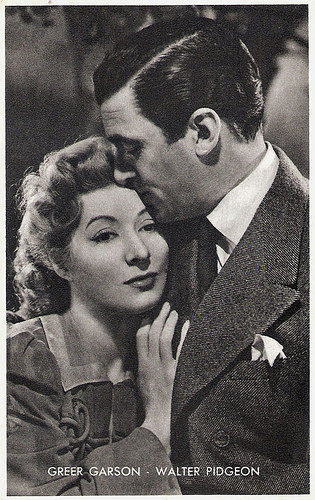
Belgian collectors card by Kwatta, Bois d'Haine, no. C. 167. Photo: Metro Goldwyn Mayer. Publicity still for Blossoms in the Dust (Mervyn Leroy, 1941).
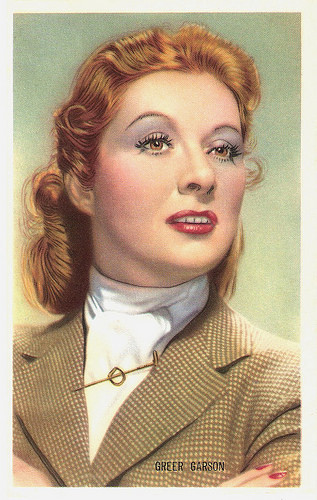
Belgian collectors card by Kwatta, Bois d'Haine, no. C. 203. Photo: Metro Goldwyn Mayer (M.G.M.).
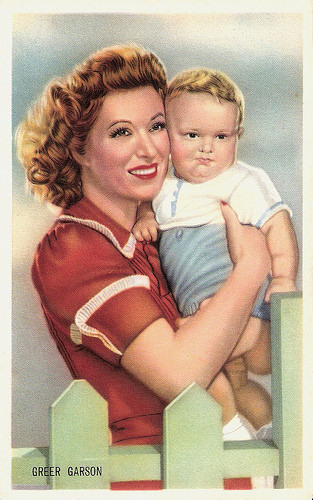
Belgian collectors card by Kwatta, Bois d'Haine, no. C 208. Photo: MGM. Publicity still for Blossoms in the Dust (Mervyn LeRoy, 1941) .
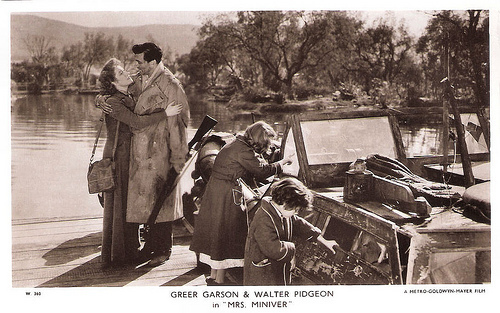
British postcard in the Picturegoer Series, London, no. W 360. Photo: MGM. Publicity still for Mrs. Miniver (1942) with Walter Pidgeon.
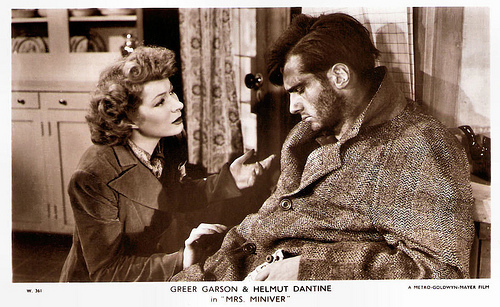
British postcard in the Picturegoer Series, London, no. W 361. Photo: MGM. Publicity still for Mrs. Miniver (1942) with Helmut Dantine.
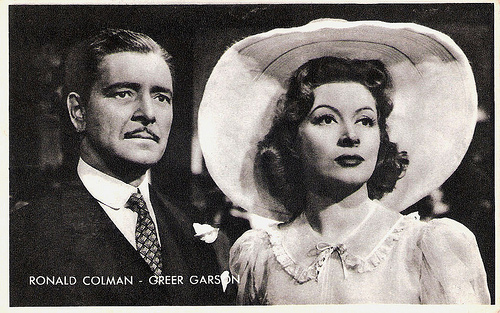
Belgian collector's card by Kwatta, Bois-D'Haine, Serie C, no. C. 170. Photo: M.G.M. Publicity still for Random Harvest (1942).
One of the 10 Most Popular Hollywood Stars
The next year Greer Garson again received critical acclaim for her role as Elizabeth Bennet in Pride and Prejudice (Robert Z. Leonard, 1940) with Laurence Olivier as Darcy. She quickly became one of the 10 most popular Hollywood stars. She starred with Joan Crawford in When Ladies Meet (Robert Z. Leonard, 1941).
That same year she became a major star with the sentimental drama Blossoms in the Dust (Mervyn Leroy, 1941), which was based on the life of Edna Gladney, who founded an orphanage in Fort Worth, Texas. It was filmed in Technicolor and audiences had their first chance to see Greer's gorgeous red hair. Walter Pidgeon was cast opposite her and their pairing would be repeated numerous times in the future. At AllMovie , Hal Erickson writes: “Greer Garson is dignity and integrity personified in the role of the real-life Edna Gladney.” The film brought her the first of five consecutive Best Actress Oscar nominations.
Garson won the Academy Award for Best Actress in 1942 for her role as a strong British wife and mother in the middle of World War II in the morale-booster Mrs. Miniver (William Wyler, 1942). Hal Erickson reviews: “As Academy Award-winning films go, Mrs. Miniver has not weathered the years all that well. This prettified, idealized view of the upper-class British home front during World War II sometimes seems over-calculated and contrived when seen today. In particular, Greer Garson's Oscar-winning performance in the title role often comes off as artificial, especially when she nobly tends her rose garden while her stalwart husband (Walter Pidgeon) participates in the evacuation at Dunkirk. However, even if the film has lost a good portion of its ability to move and inspire audiences, it is easy to see why it was so popular in 1942-and why Winston Churchill was moved to comment that its propaganda value was worth a dozen battleships. Everyone in the audience-even English audiences, closer to the events depicted in the film than American filmgoers-liked to believe that he or she was capable of behaving with as much grace under pressure as the Miniver family.”
Garson was also nominated for Madame Curie (Mervyn Leroy, 1943), Mrs. Parkington (Tay Garnett, 1944), and The Valley of Decision (Tay Garnett, 1945). Garson was partnered with Clark Gable, after his return from war service, in Adventure (Victor Fleming, 1945). The film was advertised with the catch-phrase "Gable's back and Garson's got him!" Gable argued for "He put the Arson in Garson", and she countered "She Put the Able in Gable!" Thereafter, the safer catchphrase was selected.
The war ended and the public's taste and the studio system in Hollywood began to change. Louis B. Mayer would leave MGM in a few years and Dore Schary would take his place. The elaborate expense once lavished on prestigious MGM films would be curtailed and more attention would be given to films dealing with realism and social issues. ‘Women's films’, the type of movies that Greer Garson excelled in, would no longer be a top priority.
Her downward spiral stopped with the comedy Julia Misbehaves (Jack Conway, 1948) and the hit That Forsyte Woman (Compton Bennett, 1949). The next year she reprised her role as Kay Miniver in The Miniver Story (H.C. Potter, 1950). Unfortunately it didn't fare too well, but Garson remained a prominent film star until the mid-1950s.
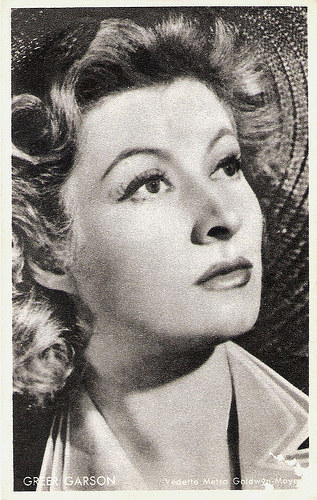
Belgian collectors card by Kwatta, Bois d'Haine, no. C. 2. Photo: Metro Goldwyn Mayer.
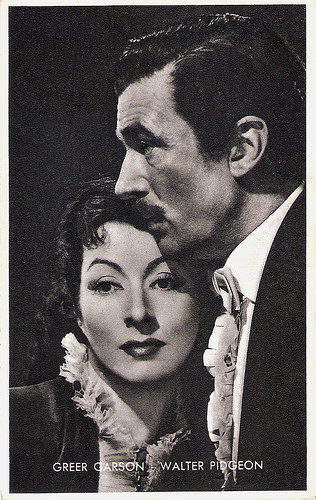
Belgian collectors card by Kwatta, Bois d'Haine, no. C. 167. Photo: Metro Goldwyn Mayer. Publicity still for Mrs. Parkington (Tay Garnett, 1944) with Walter Pidgeon.
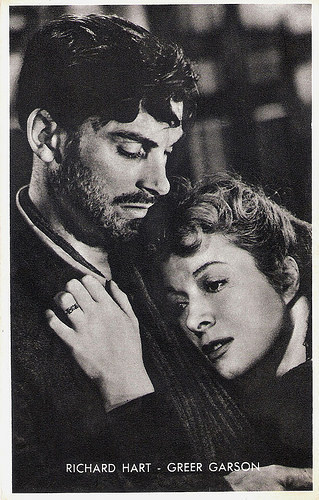
Belgian collectors card by Kwatta, Bois d'Haine, no. C. 195. Photo: Metro Goldwyn Mayer. Publicity still for Desire Me (1947) with Richard Hart.
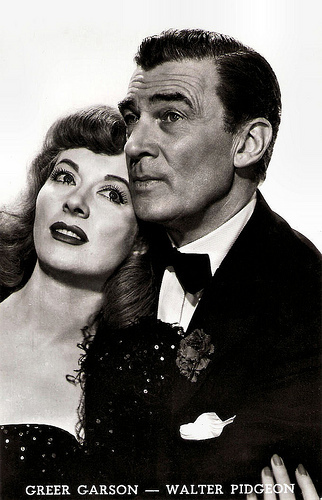
French postcard, no. 850. Photo: Metro Goldwyn Mayer (MGM).
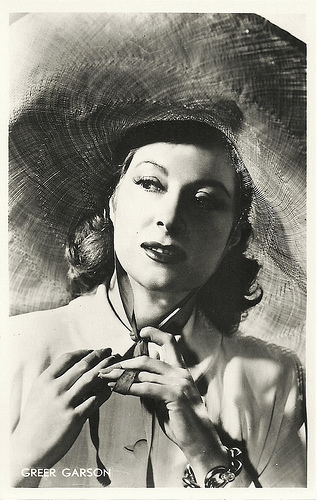
Dutch postcard by S.& v.H.A. Photo: M.P.E.A.
Her Seventh and Final Oscar Nomination
In 1951, Greer Garson became a naturalized citizen of the United States. Her films included The Law and the Lady (Edwin H. Knopf, 1951) and Julius Caesar (Joseph L. Mankiewicz, 1953) starring Marlon Brando. She made only a few films after her MGM contract expired in 1954.
She returned to the stage in late 1957 in the triumphant Auntie Mame on Broadway and earned rave reviews. She had replaced Rosalind Russell, who had gone to Hollywood to make the film version.
In 1960, Garson received her seventh and final Oscar nomination for Sunrise at Campobello (Vincent J. Donehue, 1960), in which she portrayed Eleanor Roosevelt astonishingly accurate opposite Ralph Bellamy as Franklin Roosevelt. This time she lost the Oscar to Elizabeth Taylor for Butterfield 8 (Daniel Mann, 1960).
In The Singing Nun (Henry Koster, 1966) she played the Mother Prioress opposite Debbie Reynolds as the title character. Garson's last film was Disney's The Happiest Millionaire (Norman Tokar, 1967), but she continued to make infrequent television appearances. She narrated the children's television special The Little Drummer Boy (Jules Bass, Arthur Rankin Jr., 1968), which went on to become a classic children's Christmas television program, broadcasted annually for many years.
Greer Garson was married three times. Her first marriage was to Edward Alec Abbot Snelson, a British civil servant who became a noted judge and expert in Indian and Pakistani affairs. The actual marriage in 1933 reportedly lasted only the honeymoon, but was not formally dissolved until 1943. Her second husband, whom she married in 1943, was Richard Ney, the 27-year-old actor who played her son in Mrs. Miniver (1942). They divorced in 1947. Garson claimed that Ney called her a ‘has-been’ and belittled her age. She also testified that he had physically abused her. Ney eventually became a respected stock-market analyst and financial consultant.
That same year, she married a millionaire Texas oilman and horse breeder, E. E. ‘Buddy’ Fogelson. In 1967, the couple retired to their ‘Forked Lightning Ranch’ in New Mexico. They purchased the U.S. Hall of Fame champion Thoroughbred Ack Ack from the estate of Harry F. Guggenheim in 1971, and were highly successful as breeders. They also maintained a home in Dallas, Texas, where Garson funded the Greer Garson Theater facility at Southern Methodist University. In 1975, she appeared at this theatre in The Madwoman of Challiot. It would be her final stage performance.
Garson continued to do television work, appearing in the TV series Little Women (Gordon Hessler, 1978) and The Love Boat (Richard A. Wells, 1982). In 1982, she turned down producer Aaron Spelling's offer of a part in the hit soap Dynasty (1981-1989), to play the mother of Joan Collins 's Alexis. She had to give up even these performances in the early 1980s due to chronic heart problems. In 1996 Greer Garson died from heart failure in Dallas, Texas, USA, at the age of 90.
Greer Garson meets Walter Pidgeon for the first time in Blossoms in the Dust (1941). Source: Edatola (YouTube).
Scene from That Forsyte Woman (1949) with Robert Young. Source: Edatola (YouTube).
Sources: (IMDb), Peter B. Flint (The New York Times), Hal Erickson (AllMovie), Wikipedia and .

British postcard in the Picturegoer series, London, no. W 95. Photo: Metro Goldwyn Mayer (MGM).

British postcard in the Real Photograph series, no. 203. Photo: MGM.

Dutch postcard by Weenenk & Snel, Baarn, no. 1155. Photo: MGM.

Dutch postcard, no. 3016. Photo: Metro Goldwyn Mayer (MGM).

Italian postcard. Photo: Metro Goldwyn Mayer (MGM). Publicity still for The Singing Nun/Dominique (Henry Koster, 1966).
Elegant Manner and Flaming Red Hair
Greer Garson was born Eileen Evelyn Greer Garson in Manor Park, Essex (now Greater London), England in 1904. Garson herself always claimed that she was born in Ireland in 1908. She was the only child of clerk George Garson and his Irish wife, Nancy Sophia Greer. Her father died during an appendectomy when Greer was only two. Her mother provided a living for them by managing townhouses that her husband had owned.
From 1921 on, Greer was educated at the University of London, earning a Bachelor's degree in 1926. She had intended to become a teacher, but instead began working in a research library for an advertising agency, and appeared in local theatrical productions whenever she could.
In 1931, she could start her professional stage career at the Birmingham Repertory Company and she quit her job at the ad agency. She made her first stage appearance as an American Jewish tenement girl in Street Scene. In 1934 she appeared in the short film Inasmuch... (Alec Saville, 1934) with Donald Wolfit. That same year her London stage debut came in The Tempest.
Her role in the play The Golden Arror with Laurence Olivier proved to be her breakthrough. She was suddenly very popular throughout London and offers to headline in plays and musicals poured in. She acted in a variety of plays, ranging from Shakespeare to costume dramas, but none of them were huge hits. She also appeared on BBC television during its earliest years, most notably starring in a thirty-minute production of an excerpt of Twelfth Night (1937), with Dorothy Black.
In 1937, while performing in the play Old Music, she was discovered by MGM mogul Louis B. Mayer. He was in London looking for new talent, and was entranced by her elegant manner and flaming red hair. Garson signed a seven year contract with MGM in late 1937, but did not start to work until late 1938.
When she finally made her first Hollywood film, Garson was already in her mid thirties. Goodbye Mr. Chips (Sam Wood, 1939) was based on James Hilton's short story about a beloved school master. The film was made in England and had a British cast including Robert Donat as Mr. Chips. For the role of his captivating young wife Garson received her first Oscar nomination, but lost to Vivien Leigh for Gone with the Wind (Victor Fleming, 1939).
However, Louis B. Mayer knew he had a star and she was arriving at a great time. Both of MGM's most prestigious actresses, Greta Garbo and Norma Shearer were retiring. Greer was next cast in a fluffy comedy called Remember? (Norman Z. MacLeod, 1939) while Mayer searched for quality roles for his new leading lady.

Belgian collectors card by Kwatta, Bois d'Haine, no. C. 167. Photo: Metro Goldwyn Mayer. Publicity still for Blossoms in the Dust (Mervyn Leroy, 1941).

Belgian collectors card by Kwatta, Bois d'Haine, no. C. 203. Photo: Metro Goldwyn Mayer (M.G.M.).

Belgian collectors card by Kwatta, Bois d'Haine, no. C 208. Photo: MGM. Publicity still for Blossoms in the Dust (Mervyn LeRoy, 1941) .

British postcard in the Picturegoer Series, London, no. W 360. Photo: MGM. Publicity still for Mrs. Miniver (1942) with Walter Pidgeon.

British postcard in the Picturegoer Series, London, no. W 361. Photo: MGM. Publicity still for Mrs. Miniver (1942) with Helmut Dantine.

Belgian collector's card by Kwatta, Bois-D'Haine, Serie C, no. C. 170. Photo: M.G.M. Publicity still for Random Harvest (1942).
One of the 10 Most Popular Hollywood Stars
The next year Greer Garson again received critical acclaim for her role as Elizabeth Bennet in Pride and Prejudice (Robert Z. Leonard, 1940) with Laurence Olivier as Darcy. She quickly became one of the 10 most popular Hollywood stars. She starred with Joan Crawford in When Ladies Meet (Robert Z. Leonard, 1941).
That same year she became a major star with the sentimental drama Blossoms in the Dust (Mervyn Leroy, 1941), which was based on the life of Edna Gladney, who founded an orphanage in Fort Worth, Texas. It was filmed in Technicolor and audiences had their first chance to see Greer's gorgeous red hair. Walter Pidgeon was cast opposite her and their pairing would be repeated numerous times in the future. At AllMovie , Hal Erickson writes: “Greer Garson is dignity and integrity personified in the role of the real-life Edna Gladney.” The film brought her the first of five consecutive Best Actress Oscar nominations.
Garson won the Academy Award for Best Actress in 1942 for her role as a strong British wife and mother in the middle of World War II in the morale-booster Mrs. Miniver (William Wyler, 1942). Hal Erickson reviews: “As Academy Award-winning films go, Mrs. Miniver has not weathered the years all that well. This prettified, idealized view of the upper-class British home front during World War II sometimes seems over-calculated and contrived when seen today. In particular, Greer Garson's Oscar-winning performance in the title role often comes off as artificial, especially when she nobly tends her rose garden while her stalwart husband (Walter Pidgeon) participates in the evacuation at Dunkirk. However, even if the film has lost a good portion of its ability to move and inspire audiences, it is easy to see why it was so popular in 1942-and why Winston Churchill was moved to comment that its propaganda value was worth a dozen battleships. Everyone in the audience-even English audiences, closer to the events depicted in the film than American filmgoers-liked to believe that he or she was capable of behaving with as much grace under pressure as the Miniver family.”
Garson was also nominated for Madame Curie (Mervyn Leroy, 1943), Mrs. Parkington (Tay Garnett, 1944), and The Valley of Decision (Tay Garnett, 1945). Garson was partnered with Clark Gable, after his return from war service, in Adventure (Victor Fleming, 1945). The film was advertised with the catch-phrase "Gable's back and Garson's got him!" Gable argued for "He put the Arson in Garson", and she countered "She Put the Able in Gable!" Thereafter, the safer catchphrase was selected.
The war ended and the public's taste and the studio system in Hollywood began to change. Louis B. Mayer would leave MGM in a few years and Dore Schary would take his place. The elaborate expense once lavished on prestigious MGM films would be curtailed and more attention would be given to films dealing with realism and social issues. ‘Women's films’, the type of movies that Greer Garson excelled in, would no longer be a top priority.
Her downward spiral stopped with the comedy Julia Misbehaves (Jack Conway, 1948) and the hit That Forsyte Woman (Compton Bennett, 1949). The next year she reprised her role as Kay Miniver in The Miniver Story (H.C. Potter, 1950). Unfortunately it didn't fare too well, but Garson remained a prominent film star until the mid-1950s.

Belgian collectors card by Kwatta, Bois d'Haine, no. C. 2. Photo: Metro Goldwyn Mayer.

Belgian collectors card by Kwatta, Bois d'Haine, no. C. 167. Photo: Metro Goldwyn Mayer. Publicity still for Mrs. Parkington (Tay Garnett, 1944) with Walter Pidgeon.

Belgian collectors card by Kwatta, Bois d'Haine, no. C. 195. Photo: Metro Goldwyn Mayer. Publicity still for Desire Me (1947) with Richard Hart.

French postcard, no. 850. Photo: Metro Goldwyn Mayer (MGM).

Dutch postcard by S.& v.H.A. Photo: M.P.E.A.
Her Seventh and Final Oscar Nomination
In 1951, Greer Garson became a naturalized citizen of the United States. Her films included The Law and the Lady (Edwin H. Knopf, 1951) and Julius Caesar (Joseph L. Mankiewicz, 1953) starring Marlon Brando. She made only a few films after her MGM contract expired in 1954.
She returned to the stage in late 1957 in the triumphant Auntie Mame on Broadway and earned rave reviews. She had replaced Rosalind Russell, who had gone to Hollywood to make the film version.
In 1960, Garson received her seventh and final Oscar nomination for Sunrise at Campobello (Vincent J. Donehue, 1960), in which she portrayed Eleanor Roosevelt astonishingly accurate opposite Ralph Bellamy as Franklin Roosevelt. This time she lost the Oscar to Elizabeth Taylor for Butterfield 8 (Daniel Mann, 1960).
In The Singing Nun (Henry Koster, 1966) she played the Mother Prioress opposite Debbie Reynolds as the title character. Garson's last film was Disney's The Happiest Millionaire (Norman Tokar, 1967), but she continued to make infrequent television appearances. She narrated the children's television special The Little Drummer Boy (Jules Bass, Arthur Rankin Jr., 1968), which went on to become a classic children's Christmas television program, broadcasted annually for many years.
Greer Garson was married three times. Her first marriage was to Edward Alec Abbot Snelson, a British civil servant who became a noted judge and expert in Indian and Pakistani affairs. The actual marriage in 1933 reportedly lasted only the honeymoon, but was not formally dissolved until 1943. Her second husband, whom she married in 1943, was Richard Ney, the 27-year-old actor who played her son in Mrs. Miniver (1942). They divorced in 1947. Garson claimed that Ney called her a ‘has-been’ and belittled her age. She also testified that he had physically abused her. Ney eventually became a respected stock-market analyst and financial consultant.
That same year, she married a millionaire Texas oilman and horse breeder, E. E. ‘Buddy’ Fogelson. In 1967, the couple retired to their ‘Forked Lightning Ranch’ in New Mexico. They purchased the U.S. Hall of Fame champion Thoroughbred Ack Ack from the estate of Harry F. Guggenheim in 1971, and were highly successful as breeders. They also maintained a home in Dallas, Texas, where Garson funded the Greer Garson Theater facility at Southern Methodist University. In 1975, she appeared at this theatre in The Madwoman of Challiot. It would be her final stage performance.
Garson continued to do television work, appearing in the TV series Little Women (Gordon Hessler, 1978) and The Love Boat (Richard A. Wells, 1982). In 1982, she turned down producer Aaron Spelling's offer of a part in the hit soap Dynasty (1981-1989), to play the mother of Joan Collins 's Alexis. She had to give up even these performances in the early 1980s due to chronic heart problems. In 1996 Greer Garson died from heart failure in Dallas, Texas, USA, at the age of 90.
Greer Garson meets Walter Pidgeon for the first time in Blossoms in the Dust (1941). Source: Edatola (YouTube).
Scene from That Forsyte Woman (1949) with Robert Young. Source: Edatola (YouTube).
Sources: (IMDb), Peter B. Flint (The New York Times), Hal Erickson (AllMovie), Wikipedia and .
Published on April 08, 2015 22:00
April 7, 2015
Cinémagazine-Edition
Cinémagazine-Edition was just a small publishing company located in Paris, France. But the publisher had a good reputation and the quality of its sepia star postcards from the 1920s and early 1930s are still mesmerizing.
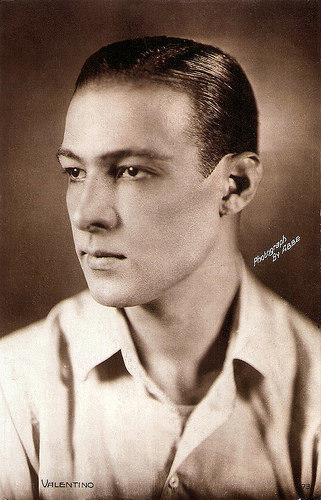
Rudolph Valentino. French postcard by Cinémagazine-Edition, Paris. Photo: James Abbe.
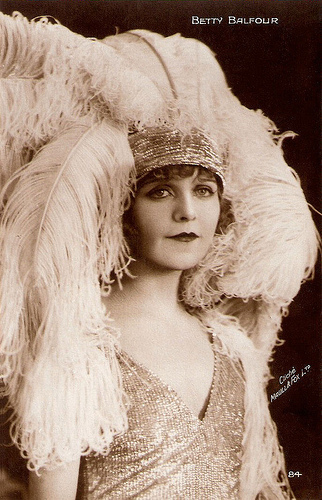
Betty Balfour. French postcard by Cinémagazine Edition, no. 84. Photo: Maull & Fox.
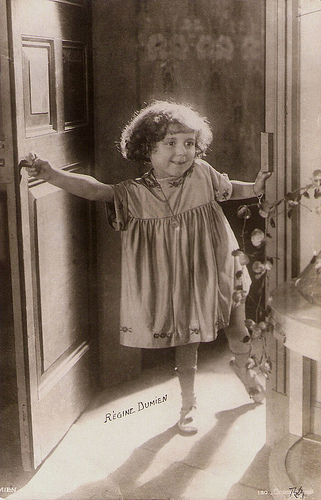
Régine Dumien . French postcard by Cinémagazine-Edition, no. 130.
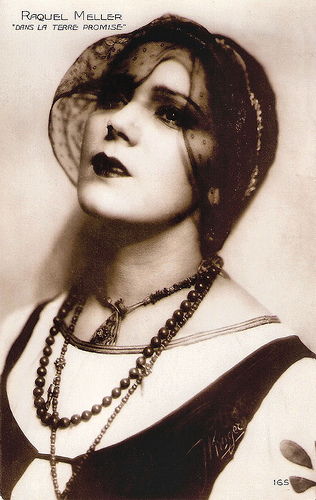
Raquel Meller. French postcard by Cinémagazine-Edition, Paris, no. 165. Photo: J. Kruger.
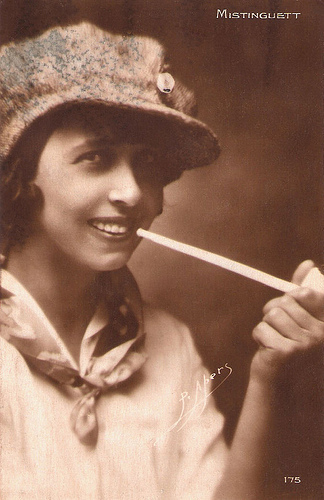
Mistinguett . French postcard by Cinémagazine-Edition, Paris, no. 175. Photo: P. Apers.
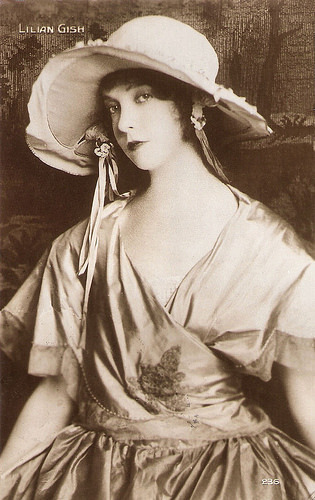
Lilian Gish. French postcard by Cinémagazine-Edition, Paris, no. 236.
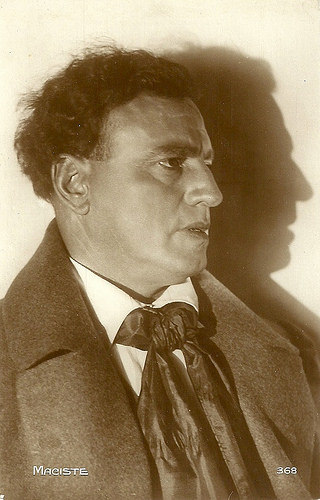
Maciste. French postcard by Editions Cinémagazine, no. 368. Bartolomeo Pagano aka Maciste in Maciste all'inferno (Guido Brignone, 1926).
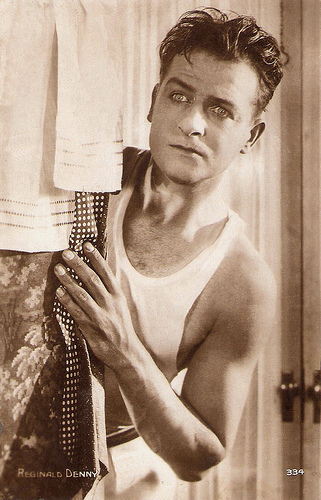
Reginald Denny . French postcard by Cinémagazine-Edition, Paris, no. 334.
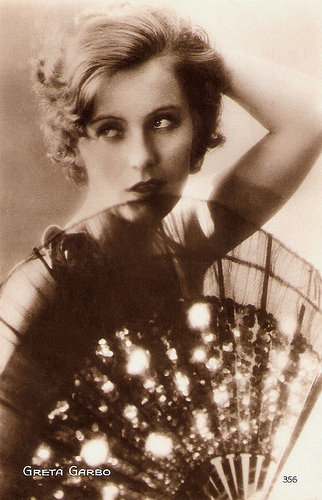
Greta Garbo . French postcard by Cinémagazine-Edition, Paris, no. 356.
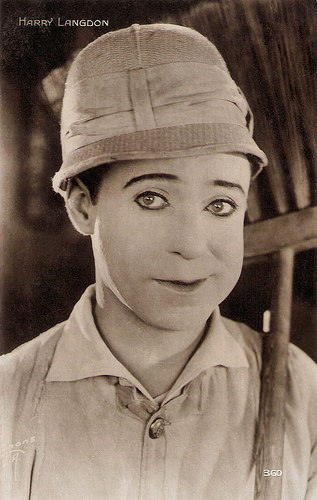
Harry Langdon. French postcard by Cinémagazine-Edition, Paris, no. 360. Photo: ...nons, Los Angeles (?).
Sepia brown tone
Cinémagazine-Edition or CE was the publisher of the film magazine of the same name, that was popular all over Europe. It was a weekly magazine that existed between 1921 and 1935. Among the authors were illustrious future directors like Marcel Carné, Jean Dréville and Robert Florey. Cinémagazine brought an attractive mix of attractive films and star iconography on the one side and more in-depth information, reviews, feature articles, on the other.
Like other publishers of film magazines, CE also produced film memorabilia such as hundreds of film star postcards. Cinémagazine-Edition published film postcards of both Hollywood stars and European stars in a sepia brown tone. At the end of the production the postcards also came in a lighter version and sometimes also the colour differed.
Most of the postcards contain studio portraits, but a few series of postcards have stills from popular films, such as the Hollywood spectacle Ben-Hur: A Tale of the Christ (Fred Niblo, 1925) and the French war drama Verdun, visions d'histoire (Léon Poirier, 1928)
All the Cinémagazine postcards were in a regular postcard format, and there were no other sizes and also no colorized merchandise.
A good identification is the company symbol, printed on each card on the lower left edge (a capital C containing a capital E). The complete name of the card collection was 'CINEMAGAZINE-EDITION, PARIS'. You can read that on the reverse side of each card, together with 'Made in France'.
The different card numbers were also on the front in the left corner. They counted from 1 (Norma Talmadge) to 1099 (Laurel and Hardy) and then from 2000 (David Newell) till 2113 ( Claude Dauphin ). In 1934 followed a 'Nouvelle serie' with a postcard of Marcelle Chantal as no. 1. This series contained about one hundred cards.
Most postcards were in a longish format. Some of the partners postcards were produced in a horizontal format. Most of the later postcards have a white frame around the photos.
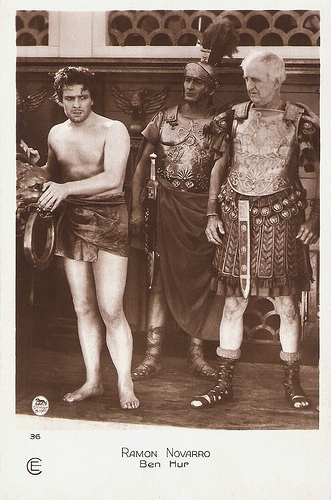
Ramon Novarro in Ben Hur. French postcard by Cinemagazine-Edition, Paris, no. 36. Photo: Metro-Goldwyn-Mayer (MGM). Publicity still for Ben-Hur: A Tale of the Christ (Fred Niblo, 1925).
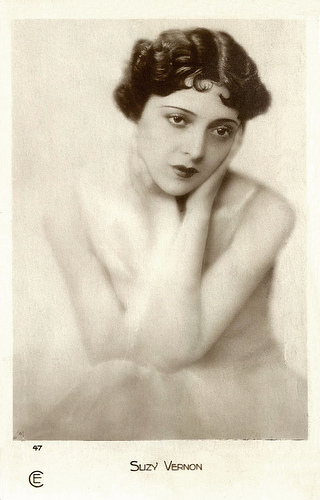
Suzy Vernon . French postcard by Editions Cinémagazine, no. 47.
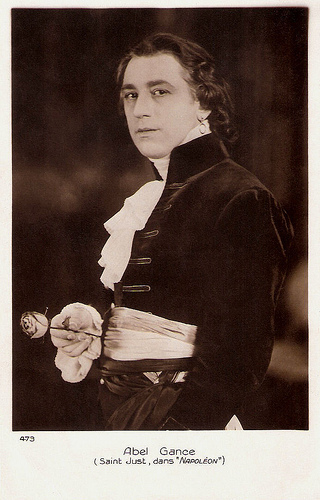
Abel Gance . French postcard by Cinémagazine-Edition, no. 473. Photo: publicity still for Napoléon (Abel Gance, 1927), with Gance himself as Saint Just.
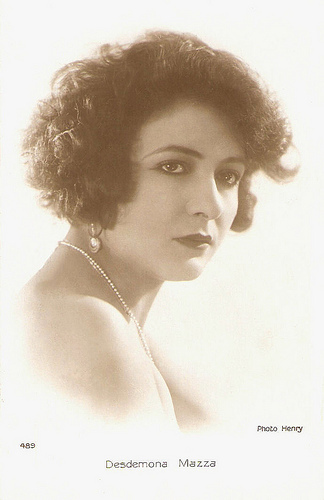
Desdemona Mazza . French postcard by Cinémagazine-Edition, Paris, no. 489. Sent by mail in 1928. Photo: Henry.
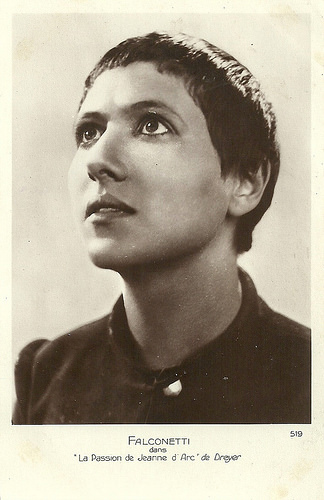
Renée Falconetti in La Passion de Jeanne d'Arc. French postcard by Editions Cinémagazine, no. 519.
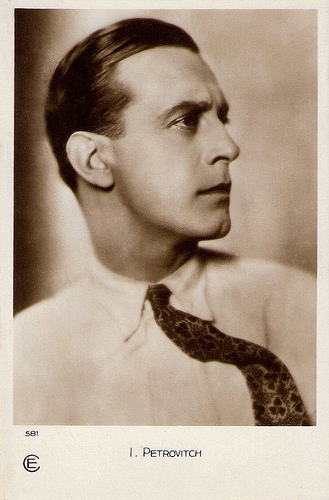
Ivan Petrovich . French postcard by Cinémagazine-Edition, Paris, no. 581.
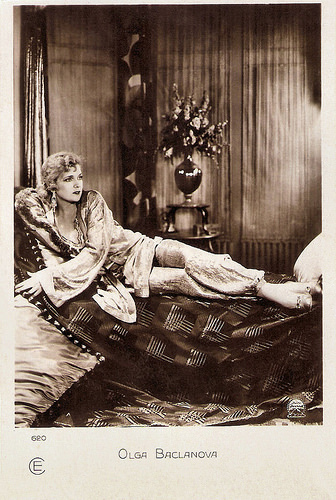
Olga Baclanova . French postcard by Cinémagazine-Edition, Paris, no. 620. Photo: Paramount.
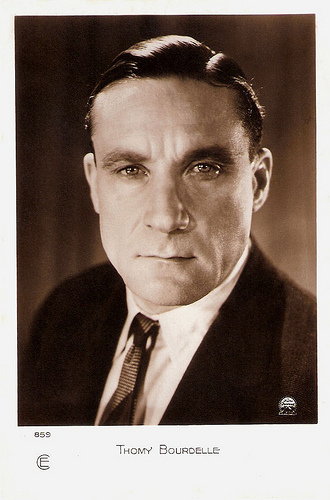
Thomy Bourdelle . French postcard by Cinémagazine-Edition, no. 859. Photo: Paramount.
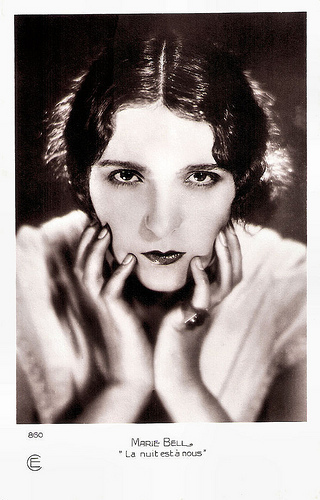
Marie Bell in La nuit est à nous. French postcard by Cinémagazine-Edition, no. 860.
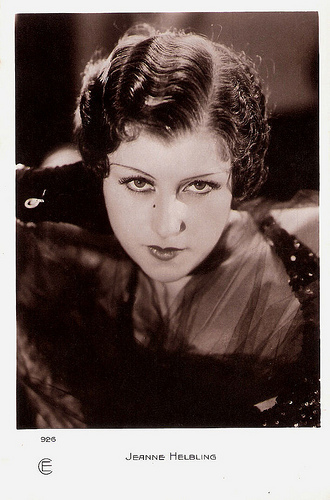
Jeanne Helbling . French postcard by Cinémagazine-Edition (CE), Paris, no. 926.
This was the fourth post in a new series on film star postcard publishers. For earlier posts, see the links at right under the caption 'The Publishers'. Next Wednesday: the Dutch publisher JSA.
Source: Garbo Forever, Gallica and Cinema Players Postal Antiquities.

Rudolph Valentino. French postcard by Cinémagazine-Edition, Paris. Photo: James Abbe.

Betty Balfour. French postcard by Cinémagazine Edition, no. 84. Photo: Maull & Fox.

Régine Dumien . French postcard by Cinémagazine-Edition, no. 130.

Raquel Meller. French postcard by Cinémagazine-Edition, Paris, no. 165. Photo: J. Kruger.

Mistinguett . French postcard by Cinémagazine-Edition, Paris, no. 175. Photo: P. Apers.

Lilian Gish. French postcard by Cinémagazine-Edition, Paris, no. 236.

Maciste. French postcard by Editions Cinémagazine, no. 368. Bartolomeo Pagano aka Maciste in Maciste all'inferno (Guido Brignone, 1926).

Reginald Denny . French postcard by Cinémagazine-Edition, Paris, no. 334.

Greta Garbo . French postcard by Cinémagazine-Edition, Paris, no. 356.

Harry Langdon. French postcard by Cinémagazine-Edition, Paris, no. 360. Photo: ...nons, Los Angeles (?).
Sepia brown tone
Cinémagazine-Edition or CE was the publisher of the film magazine of the same name, that was popular all over Europe. It was a weekly magazine that existed between 1921 and 1935. Among the authors were illustrious future directors like Marcel Carné, Jean Dréville and Robert Florey. Cinémagazine brought an attractive mix of attractive films and star iconography on the one side and more in-depth information, reviews, feature articles, on the other.
Like other publishers of film magazines, CE also produced film memorabilia such as hundreds of film star postcards. Cinémagazine-Edition published film postcards of both Hollywood stars and European stars in a sepia brown tone. At the end of the production the postcards also came in a lighter version and sometimes also the colour differed.
Most of the postcards contain studio portraits, but a few series of postcards have stills from popular films, such as the Hollywood spectacle Ben-Hur: A Tale of the Christ (Fred Niblo, 1925) and the French war drama Verdun, visions d'histoire (Léon Poirier, 1928)
All the Cinémagazine postcards were in a regular postcard format, and there were no other sizes and also no colorized merchandise.
A good identification is the company symbol, printed on each card on the lower left edge (a capital C containing a capital E). The complete name of the card collection was 'CINEMAGAZINE-EDITION, PARIS'. You can read that on the reverse side of each card, together with 'Made in France'.
The different card numbers were also on the front in the left corner. They counted from 1 (Norma Talmadge) to 1099 (Laurel and Hardy) and then from 2000 (David Newell) till 2113 ( Claude Dauphin ). In 1934 followed a 'Nouvelle serie' with a postcard of Marcelle Chantal as no. 1. This series contained about one hundred cards.
Most postcards were in a longish format. Some of the partners postcards were produced in a horizontal format. Most of the later postcards have a white frame around the photos.

Ramon Novarro in Ben Hur. French postcard by Cinemagazine-Edition, Paris, no. 36. Photo: Metro-Goldwyn-Mayer (MGM). Publicity still for Ben-Hur: A Tale of the Christ (Fred Niblo, 1925).

Suzy Vernon . French postcard by Editions Cinémagazine, no. 47.

Abel Gance . French postcard by Cinémagazine-Edition, no. 473. Photo: publicity still for Napoléon (Abel Gance, 1927), with Gance himself as Saint Just.

Desdemona Mazza . French postcard by Cinémagazine-Edition, Paris, no. 489. Sent by mail in 1928. Photo: Henry.

Renée Falconetti in La Passion de Jeanne d'Arc. French postcard by Editions Cinémagazine, no. 519.

Ivan Petrovich . French postcard by Cinémagazine-Edition, Paris, no. 581.

Olga Baclanova . French postcard by Cinémagazine-Edition, Paris, no. 620. Photo: Paramount.

Thomy Bourdelle . French postcard by Cinémagazine-Edition, no. 859. Photo: Paramount.

Marie Bell in La nuit est à nous. French postcard by Cinémagazine-Edition, no. 860.

Jeanne Helbling . French postcard by Cinémagazine-Edition (CE), Paris, no. 926.
This was the fourth post in a new series on film star postcard publishers. For earlier posts, see the links at right under the caption 'The Publishers'. Next Wednesday: the Dutch publisher JSA.
Source: Garbo Forever, Gallica and Cinema Players Postal Antiquities.
Published on April 07, 2015 22:00
April 6, 2015
Violetta Napierska
Film actress Violetta Napierska (?-?) appeared mainly in the German silent cinema. She co-starred with Béla Lugosi and Lee Parry in the horror film Hypnose/Hypnosis (1920) and in several other films produced and directed by Richard Eichberg.
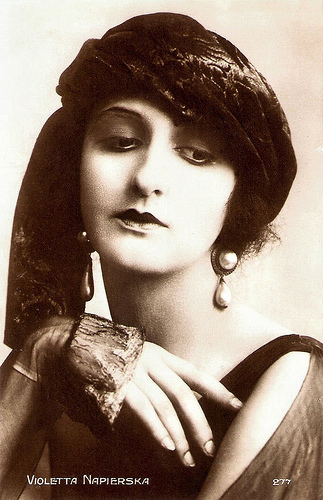
French postcard by Cinémagazine-Edition, Paris, no. 277.
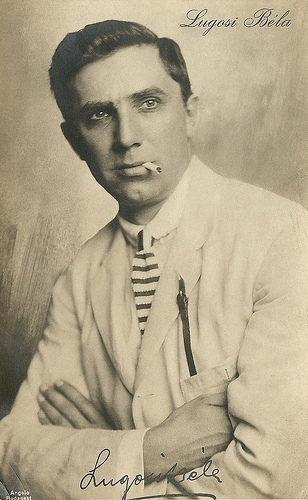
Béla Lugosi. Hungarian postcard. Photo: Angelo, Budapest. Collection: Didier Hanson.
'Béla Lugosi’s Mistress'
There is not much known about Violetta (sometimes Violette) Napierska.
From 1919 on she appeared in German silent films like Sünden der Eltern/Sins of the Elders (Richard Eichberg, 1919) and Nonne und Tänzerin/Nun and Dancer (Richard Eichberg, 1919), both starring German star Lee Parry .
She then appeared in Die Abenteuer der Marquise von Königsmarck/The Adventures of the Marquise of Königsmarck (Emmerich Hanus, 1920) with Heinrich Schroth. For Richard Eichberg-Film she next appeared in the two-part Der Fluch der Menschheit/The Curse of Man (Richard Eichberg, 1920) starring Lee Parry and Béla Lugosi .
According to Wikipedia Napierska was Lugosi’s mistress at the time. According to a MySpace blog on Lugosi, he had only fallen in love with her and he even wrote her a poem: “One (poem) I wrote while living in Germany, working in the Budapest Theatre. I had fallen in love with a very young girl by the name of Violetta Napierska. Regretfully, nothing ever developed from our acquaintance.”
Lugosi and Napierska worked together again on the film Hypnose/Hypnosis (Richard Eichberg, 1920) and the two-parter Der Tanz auf dem Vulkan/Dance on the Volcano (Richard Eichberg, 1920), both co-starring again Lee Parry . The U.S. version of the latter film was known as Daughter of the Night. For a long time, it was considered a lost film until an archive print was discovered in its American release version in the 1990s.
The success of these films led to another cooperation of the director and his stars: Ihre Hoheit die Tänzerin/Her Highness the Dancer (Richard Eichberg, 1922). The film was banned by the German Film Review Office and it could not to be shown in the Weimar Republic. The makers appealed, but the Office considered the film ‘corruptive’ and the appeal was rejected. A shortened version was again not approved. Finally in early 1923 a version of the film, now renamed Der Leidensweg der Eva Grunwald/The Ordeal of Eva Grunwald was approved, but considered suitable for adults only.
Napierska also starred in films of director Franz Osten such as in Die Kette der Schuld/The Chain of Guilt (Franz Osten, 1921) and Der Verfluchte/The Cursed (Franz Osten, 1921). Opposite Ludwig Trautmann she appeared in Die graue Macht/The gray power (Fred Stranz, 1923). Her last German film was Der Mitternachtszug/The Midnight Train (James Bauer, 1923).
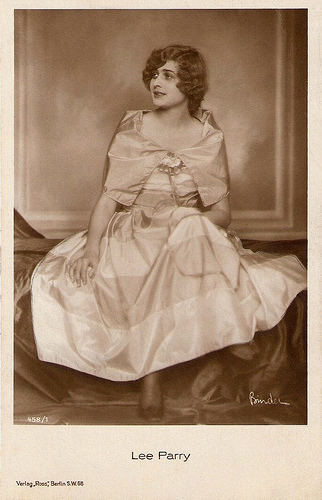
Lee Parry . German postcard by Ross Verlag, no. 458/1, 1919-1924 (at the backside of the card is hand written: 1920). Photo: Alex Binder.
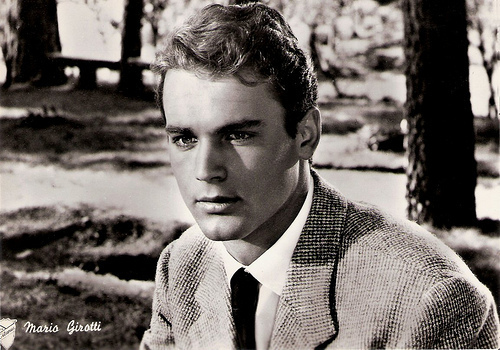
Mario Girotti. Italian postcard by Bromofoto, Milano (Milan), no. 1807.
Oedipal Relationship
Violetta Napierska moved to France, where she appeared in Le p'tit Parigot/The Small Parisian One (René Le Somptier, 1926), a serial in six parts, which starred Georges Biscot, and was based on a story by Paul Cartoux and Henri Decoin.
After that Violetta Napierska stayed in France and retired from the film business. After the introduction of sound film she returned in supporting parts in the films La coqueluche de ces dames/The darling of These Ladies (Gabriel Rosca, 1935) with Lisette Lanvin , and Coeur de gueux/Rogue’s Heart (Jean Epstein, 1936) starring Madeleine Renaud . She also appeared in the Italian version Cuor di vagabondo/Rogue’s Heart (Jean Epstein, 1936) with Renaud and Fosco Giachetti .
In 1955 she appeared in Italy in her final film La Vena d'Oro/The gold Vein (1955, Mauro Bolognini) about an oedipal relationship between a mother ( Märta Torén ) and her only son. As the son appeared the then 16-year-old Mario Girotti , who would become Spaghetti Western hero Terence Hill in 1967.
Violetta Napierska retired and was soon forgotten. When or where she passed away is not known. But in the music scene her name is not forgotten. In 1997 the American band Darling Violetta took their name from the salutation used by Béla Lugosi in a poem for Violetta Napierska:
My Darling Violetta,
Slumber envelops your beautiful face
And a dream grips your soul in embrace;
I will guard you.
You are my dream every night, every day,
And regardless of where you might stay,
I will seek you.
Then, when you want to forget all the world,
And fly to my arms like a bird,
I will love you.
Signed,
Bela
Videoclip of Spolied and Rotten by Darling Violetta. Source: GMiddleman (YouTube).
Sources: Béla Lugosi (MySpace), Thomas Staedeli (Cyranos), Wikipedia, and .

French postcard by Cinémagazine-Edition, Paris, no. 277.

Béla Lugosi. Hungarian postcard. Photo: Angelo, Budapest. Collection: Didier Hanson.
'Béla Lugosi’s Mistress'
There is not much known about Violetta (sometimes Violette) Napierska.
From 1919 on she appeared in German silent films like Sünden der Eltern/Sins of the Elders (Richard Eichberg, 1919) and Nonne und Tänzerin/Nun and Dancer (Richard Eichberg, 1919), both starring German star Lee Parry .
She then appeared in Die Abenteuer der Marquise von Königsmarck/The Adventures of the Marquise of Königsmarck (Emmerich Hanus, 1920) with Heinrich Schroth. For Richard Eichberg-Film she next appeared in the two-part Der Fluch der Menschheit/The Curse of Man (Richard Eichberg, 1920) starring Lee Parry and Béla Lugosi .
According to Wikipedia Napierska was Lugosi’s mistress at the time. According to a MySpace blog on Lugosi, he had only fallen in love with her and he even wrote her a poem: “One (poem) I wrote while living in Germany, working in the Budapest Theatre. I had fallen in love with a very young girl by the name of Violetta Napierska. Regretfully, nothing ever developed from our acquaintance.”
Lugosi and Napierska worked together again on the film Hypnose/Hypnosis (Richard Eichberg, 1920) and the two-parter Der Tanz auf dem Vulkan/Dance on the Volcano (Richard Eichberg, 1920), both co-starring again Lee Parry . The U.S. version of the latter film was known as Daughter of the Night. For a long time, it was considered a lost film until an archive print was discovered in its American release version in the 1990s.
The success of these films led to another cooperation of the director and his stars: Ihre Hoheit die Tänzerin/Her Highness the Dancer (Richard Eichberg, 1922). The film was banned by the German Film Review Office and it could not to be shown in the Weimar Republic. The makers appealed, but the Office considered the film ‘corruptive’ and the appeal was rejected. A shortened version was again not approved. Finally in early 1923 a version of the film, now renamed Der Leidensweg der Eva Grunwald/The Ordeal of Eva Grunwald was approved, but considered suitable for adults only.
Napierska also starred in films of director Franz Osten such as in Die Kette der Schuld/The Chain of Guilt (Franz Osten, 1921) and Der Verfluchte/The Cursed (Franz Osten, 1921). Opposite Ludwig Trautmann she appeared in Die graue Macht/The gray power (Fred Stranz, 1923). Her last German film was Der Mitternachtszug/The Midnight Train (James Bauer, 1923).

Lee Parry . German postcard by Ross Verlag, no. 458/1, 1919-1924 (at the backside of the card is hand written: 1920). Photo: Alex Binder.

Mario Girotti. Italian postcard by Bromofoto, Milano (Milan), no. 1807.
Oedipal Relationship
Violetta Napierska moved to France, where she appeared in Le p'tit Parigot/The Small Parisian One (René Le Somptier, 1926), a serial in six parts, which starred Georges Biscot, and was based on a story by Paul Cartoux and Henri Decoin.
After that Violetta Napierska stayed in France and retired from the film business. After the introduction of sound film she returned in supporting parts in the films La coqueluche de ces dames/The darling of These Ladies (Gabriel Rosca, 1935) with Lisette Lanvin , and Coeur de gueux/Rogue’s Heart (Jean Epstein, 1936) starring Madeleine Renaud . She also appeared in the Italian version Cuor di vagabondo/Rogue’s Heart (Jean Epstein, 1936) with Renaud and Fosco Giachetti .
In 1955 she appeared in Italy in her final film La Vena d'Oro/The gold Vein (1955, Mauro Bolognini) about an oedipal relationship between a mother ( Märta Torén ) and her only son. As the son appeared the then 16-year-old Mario Girotti , who would become Spaghetti Western hero Terence Hill in 1967.
Violetta Napierska retired and was soon forgotten. When or where she passed away is not known. But in the music scene her name is not forgotten. In 1997 the American band Darling Violetta took their name from the salutation used by Béla Lugosi in a poem for Violetta Napierska:
My Darling Violetta,
Slumber envelops your beautiful face
And a dream grips your soul in embrace;
I will guard you.
You are my dream every night, every day,
And regardless of where you might stay,
I will seek you.
Then, when you want to forget all the world,
And fly to my arms like a bird,
I will love you.
Signed,
Bela
Videoclip of Spolied and Rotten by Darling Violetta. Source: GMiddleman (YouTube).
Sources: Béla Lugosi (MySpace), Thomas Staedeli (Cyranos), Wikipedia, and .
Published on April 06, 2015 22:00
April 5, 2015
Erich Schellow
Tall and slender Erich Schellow (1915-1995) was one of the great actors of the Berlin theatre. He also worked incidentally for the cinema.
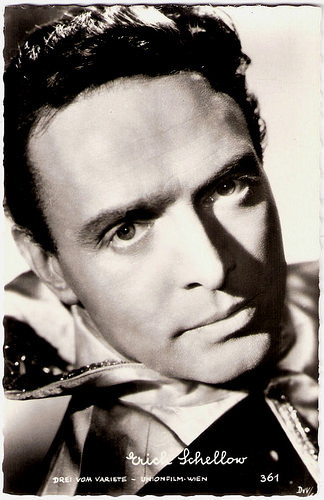
Austrian postcard by Verlag Hubmann, Wien (Vienna), no. 361. Photo: Unionfilm, Wien. Publicity still for Drei vom Variété/Three from Variety (Kurt Neumann, 1954).
A major character actor
Erich Schellow was born in Berlin in 1915. He was the son of a merchant. During his school years, Schellow already acted extensively in school plays. After graduation, he initially wanted to study art history and philosophy, but he chose for a theatre career on the advice of the actress Lola Müthel.
From 1935 till 1937, he attended the drama school of the Preußischen Staatstheater (Prussian State Theatre) under Walter Franck, Lothar Müthel, Hermine Körner and Maria Koppenhöfer.
In 1937, he made his stage debut as Mortimer in Friedrich Schiller's Maria Stuart (Mary Stuart) at the Deutschen Volkstheater (German National Theatre) in Hamburg-Altona, where he was engaged until 1940. In 1941 he moved to the Preußischen Staatstheater in Berlin, where he remained under contract until 1945. Apart from a further short engagement in Hamburg and guest appearances in Zurich and Vienna (at the Burgtheater), Berlin would remain the centre of his artistic career.
From 1948 on, Erich Schellow was a member of the Staatlichen Schauspielbühnen (State Theatre stages) in Berlin. From the young hero roles he developed into a major character actor, who interpreted Shakespeare's Hamlet, Goethe's Faust and Mephisto and Schiller’s Don Carlos. One of his outstanding roles was George in the German premiere of Edward Albee's Who's Afraid of Virginia Woolf? directed by Boleslaw Barlog in 1963.
He performed mainly in the Schiller Theater and remained there until its closure in 1993. Schellow complained against the termination of the theatre, which he saw as his ‘second home’. He and his colleagues went actively in the streets to protest about this. For his contributions to the theatre, Schellow received several awards, including the Bundesverdienstkreuz (the German Order of Merit), the Berliner Kunstpreis (the Berlin Art Prize which he won twice) and the German Critics Award.
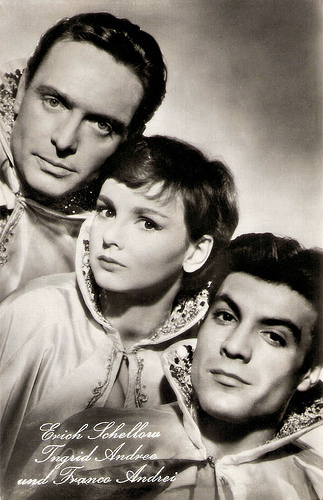
East-German postcard by VEB Progress Film-Vertrieb, Berlin, no. 222, 1957. Photo: Standard-film, Wien. Publicity still for Drei vom Variété/Three from Variety (Kurt Neumann, 1954) with Erich Schellow, Ingrid Andree and Franco Andrei .
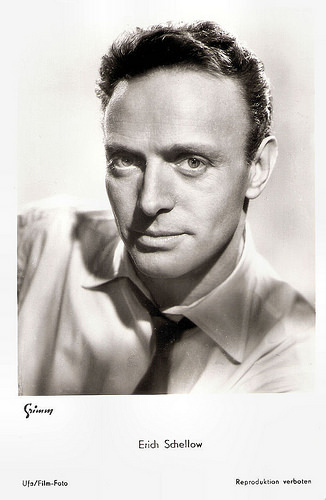
German postcard by Ufa, Berlin-Tempelhof, no. FK 1471. Photo: Arthur Grimm.
The viewpoint of an automobile
Erich Schellow rarely took on film and television roles. He played for director Helmut Käutner in the Trummerfilm In jenen Tagen/In those days (1947). The film is an episodic recollection of life under the Third Reich, told from the viewpoint of an automobile. Each of the car's various owners is in one way or another a victim of Nazism.
He also played in Käutner’s Bildnis einer Unbekannten/Portrait of an Unknown Woman (Helmut Käutner, 1954) with Ruth Leuwerik . He costarred with French actress Etchika Choureau in the comedy Ein Mädchen aus Paris/A girl from Paris (Franz Seitz, 1954).
Schellow appeared in the social study Die Stadt ist voller Geheimnisse/This Town is Full of Secrets (Fritz Kortner, 1954) opposite Annemarie Düringer, and in the saga Hotel Adlon (Josef von Báky, 1955). He also played with the popular German film star Hans Albers in Vor Sonnenuntergang/Before Sundown (Gottfried Reinhardt 1956) which won the Golden Globe as best foreign film of the year, and with another popular film star, Heinz Rühmann , in Der Hauptmann von Köpenick/The Captain of Köpenick (Helmut Käutner, 1956).
In Der 20. Juli/The Plot to Assassinate Hitler (Falk Harnack, 1955), he was seen as a Protestant pastor. On television, Schellow slipped in the role of Arthur Conan Doyle’s Sherlock Holmes for six episodes of the series Sherlock Holmes (Paul May, 1967-1968) with Paul Edwin Roth as Dr. Watson. For this performance the Deutsche Sherlock-Holmes-Gesellschaft (German Sherlock Holmes Society) appointed him as its first honorary member in 1991.
Schellow also worked occasionally as a dubbing actor. He was the German voice for Mel Ferrer in War and Peace (King Vidor, 1955), Vittorio Gassman in La tempest/Tempest (Alberto Lattuada, 1958), Peter Cushing in Dracula (Terence Fisher, 1958) and The Mummy (Terence Fisher, 1959) and Rex Harrison in Midnight Lace (David Miller, 1960).
Deeply shocked about the termination of ‘his’ Schiller theatre, Erich Schellow had a severe stroke in 1993. From then on he was paralyzed. In 1995, he died in his home town of Berlin. He was 80. He was survived by his wife Elke and their son Alexander.
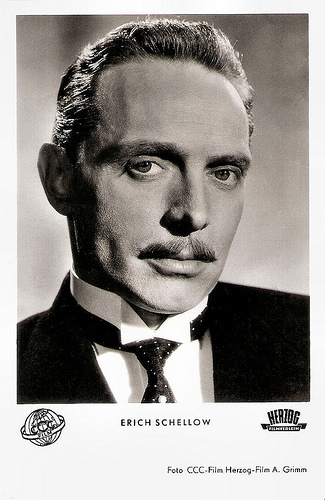
German postcard by Kunst und Bild, Berlin, no. I 423. Photo: CCC-Film / Herzog-Film / Arthur Grimm. Publicity still for Hotel Adlon (Josef von Báky, 1955).
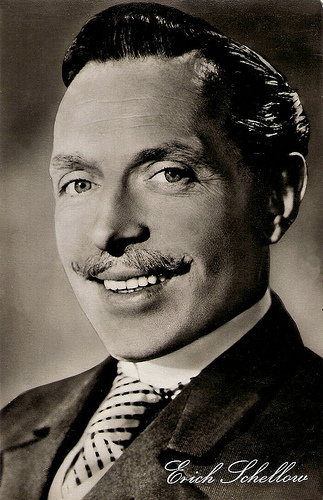
East-German postcard by VEB Progress Film-Vertrieb, Berlin, no. 312, 1957. Photo: Real Film. Publicity still for Der Hauptmann von Köpenick/The Captain from Köpenick (Helmut Käutner, 1956).
Sources: Hal Erickson (AllMovie), Stephanie D’heil (Steffi-Line - German), Wikipedia (German) and .

Austrian postcard by Verlag Hubmann, Wien (Vienna), no. 361. Photo: Unionfilm, Wien. Publicity still for Drei vom Variété/Three from Variety (Kurt Neumann, 1954).
A major character actor
Erich Schellow was born in Berlin in 1915. He was the son of a merchant. During his school years, Schellow already acted extensively in school plays. After graduation, he initially wanted to study art history and philosophy, but he chose for a theatre career on the advice of the actress Lola Müthel.
From 1935 till 1937, he attended the drama school of the Preußischen Staatstheater (Prussian State Theatre) under Walter Franck, Lothar Müthel, Hermine Körner and Maria Koppenhöfer.
In 1937, he made his stage debut as Mortimer in Friedrich Schiller's Maria Stuart (Mary Stuart) at the Deutschen Volkstheater (German National Theatre) in Hamburg-Altona, where he was engaged until 1940. In 1941 he moved to the Preußischen Staatstheater in Berlin, where he remained under contract until 1945. Apart from a further short engagement in Hamburg and guest appearances in Zurich and Vienna (at the Burgtheater), Berlin would remain the centre of his artistic career.
From 1948 on, Erich Schellow was a member of the Staatlichen Schauspielbühnen (State Theatre stages) in Berlin. From the young hero roles he developed into a major character actor, who interpreted Shakespeare's Hamlet, Goethe's Faust and Mephisto and Schiller’s Don Carlos. One of his outstanding roles was George in the German premiere of Edward Albee's Who's Afraid of Virginia Woolf? directed by Boleslaw Barlog in 1963.
He performed mainly in the Schiller Theater and remained there until its closure in 1993. Schellow complained against the termination of the theatre, which he saw as his ‘second home’. He and his colleagues went actively in the streets to protest about this. For his contributions to the theatre, Schellow received several awards, including the Bundesverdienstkreuz (the German Order of Merit), the Berliner Kunstpreis (the Berlin Art Prize which he won twice) and the German Critics Award.

East-German postcard by VEB Progress Film-Vertrieb, Berlin, no. 222, 1957. Photo: Standard-film, Wien. Publicity still for Drei vom Variété/Three from Variety (Kurt Neumann, 1954) with Erich Schellow, Ingrid Andree and Franco Andrei .

German postcard by Ufa, Berlin-Tempelhof, no. FK 1471. Photo: Arthur Grimm.
The viewpoint of an automobile
Erich Schellow rarely took on film and television roles. He played for director Helmut Käutner in the Trummerfilm In jenen Tagen/In those days (1947). The film is an episodic recollection of life under the Third Reich, told from the viewpoint of an automobile. Each of the car's various owners is in one way or another a victim of Nazism.
He also played in Käutner’s Bildnis einer Unbekannten/Portrait of an Unknown Woman (Helmut Käutner, 1954) with Ruth Leuwerik . He costarred with French actress Etchika Choureau in the comedy Ein Mädchen aus Paris/A girl from Paris (Franz Seitz, 1954).
Schellow appeared in the social study Die Stadt ist voller Geheimnisse/This Town is Full of Secrets (Fritz Kortner, 1954) opposite Annemarie Düringer, and in the saga Hotel Adlon (Josef von Báky, 1955). He also played with the popular German film star Hans Albers in Vor Sonnenuntergang/Before Sundown (Gottfried Reinhardt 1956) which won the Golden Globe as best foreign film of the year, and with another popular film star, Heinz Rühmann , in Der Hauptmann von Köpenick/The Captain of Köpenick (Helmut Käutner, 1956).
In Der 20. Juli/The Plot to Assassinate Hitler (Falk Harnack, 1955), he was seen as a Protestant pastor. On television, Schellow slipped in the role of Arthur Conan Doyle’s Sherlock Holmes for six episodes of the series Sherlock Holmes (Paul May, 1967-1968) with Paul Edwin Roth as Dr. Watson. For this performance the Deutsche Sherlock-Holmes-Gesellschaft (German Sherlock Holmes Society) appointed him as its first honorary member in 1991.
Schellow also worked occasionally as a dubbing actor. He was the German voice for Mel Ferrer in War and Peace (King Vidor, 1955), Vittorio Gassman in La tempest/Tempest (Alberto Lattuada, 1958), Peter Cushing in Dracula (Terence Fisher, 1958) and The Mummy (Terence Fisher, 1959) and Rex Harrison in Midnight Lace (David Miller, 1960).
Deeply shocked about the termination of ‘his’ Schiller theatre, Erich Schellow had a severe stroke in 1993. From then on he was paralyzed. In 1995, he died in his home town of Berlin. He was 80. He was survived by his wife Elke and their son Alexander.

German postcard by Kunst und Bild, Berlin, no. I 423. Photo: CCC-Film / Herzog-Film / Arthur Grimm. Publicity still for Hotel Adlon (Josef von Báky, 1955).

East-German postcard by VEB Progress Film-Vertrieb, Berlin, no. 312, 1957. Photo: Real Film. Publicity still for Der Hauptmann von Köpenick/The Captain from Köpenick (Helmut Käutner, 1956).
Sources: Hal Erickson (AllMovie), Stephanie D’heil (Steffi-Line - German), Wikipedia (German) and .
Published on April 05, 2015 22:00
April 4, 2015
Doris Abesser
East-German actress Doris Abesser (1935) appeared since 1956 in several films by the DEFA and became one of the studio’s most popular stars. She worked with important directors like Frank Beyer, Heiner Carow und Kurt Maetzig. After the film Der Frühling braucht Zeit/Spring takes time (1965) was banned, the promising film career of the fresh and girly actress stalled.
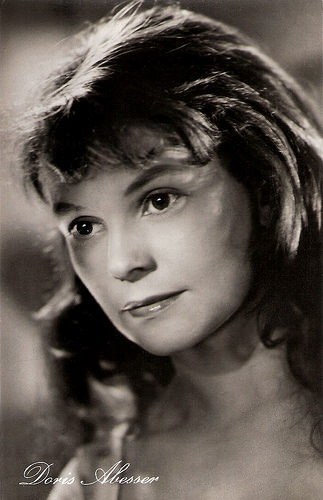
East-German postcard by VEB Progress Filmvertrieb, Berlin, no. 1368. Photo: DEFA / Neufeld.
Cold War years
Doris Abesser was born in Berlin in 1935. During her youth she discovered her passion for acting. At 16, she took her first acting classes and trained at the Drama School of the Deutsches Theater in Berlin.
In 1956, she made her stage debut at the Theater der Bergarbeiter in Senftenberg, where she worked for three years. In 1959, she moved to the Dresden State Theatre and two years later she went to play at the Volksbühne in Berlin.
During the Cold War years, she was used several times in anti-capitalist film productions of the former GDR. Her film debut was in the DEFA production Zwischenfall in Benderath/Incident in Benderath (János Veiczi, 1956) with Uwe-Jens Pape.
She appeared with Gisela May in the drama Eine alte Liebe/An old love (Frank Beyer, 1959). In Das Leben beginnt/Life Begins (Heiner Carow, 1959) she fled to the West and later came back disappointed. In Septemberliebe/September Love (Kurt Maetzig, 1960) she held her friend (Ulrich Thein) from such a flight.
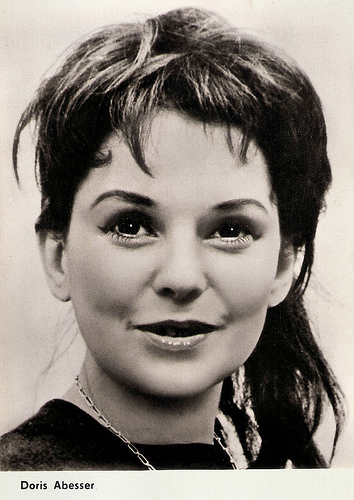
East-German postcard by VEB Progress Filmvertrieb, Berlin, no. 1746, 1963. Photo: Thomas Klamann.
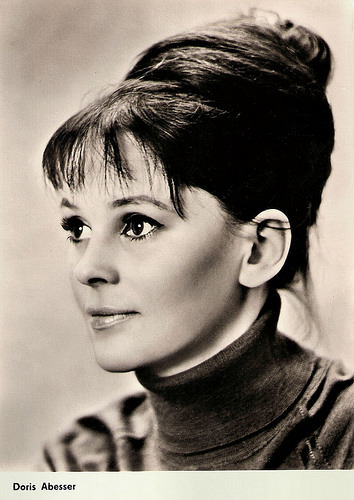
East-German postcard by VEB Progress Filmvertrieb, Berlin, no. 2115, 1964. Photo: Ludwig Schirmer.
The Witch of the West
In 1961, Doris Abesser was chosen as ´Filmliebling des Jahres 1961´ (Favourite Film Star of 1961) by the youth magazine Neues Leben, and she won 1961 the Erich-Weinert-Medaille (an art award of the FDJ - the official socialist youth movement of the GDR).
A success was the drama Professor Mamlock (Konrad Wolf, 1961), in which she played the Jewish Ruth Mamlock, the professor’s daughter.
Then she played in the DEFA film Der Frühling braucht Zeit/Spring takes time (1965), directed by her husband Günter Stahnke. The film investigates the causes of an industrial accident. To blame are amongst others the lack of competence and the inefficient operation of the enterprise, the distrust of non-party specialists. The socio-critical production was banned shortly after its premiere.
After this, the DEFA offered her no more lead roles in the studio’s productions. Years later, the film won two awards at the Berlin Film Festival 1990.
Abesser played in the theatre, such as at the Friedrich-Wolf-Theater in Neustrelitz, where she starred as Eliza Dolittle in the musical My Fair Lady and as the Witch of the West in The Wizzard of Oz. From 1968 to 1997 she was a member of the Metropol Theater in Berlin.
Since the 1990s, she performed in literary and musical programs on stage and on the radio. She also works for television, and guest starred in the crime series Polizeiruf 110 (1977, 1989, 1995), Tatort (2001) and SOKO Leipzig (2005). She also played the lead in the series Geschichten übern Gartenzaun/Stories over the garden fence (1982–1985).
Doris Abesser was married to the German director Günter Stahnke, but they divorced. The couple has a son, Robert (1963). Doris Abesser lives in Berlin.
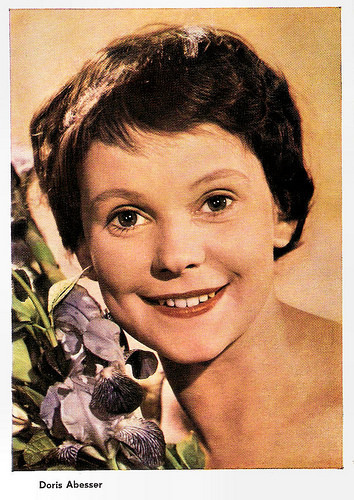
East-German postcard by VEB Progress Filmvertrieb, Berlin, no. 1329 F, 1960. Photo: Kurt Wunsch.
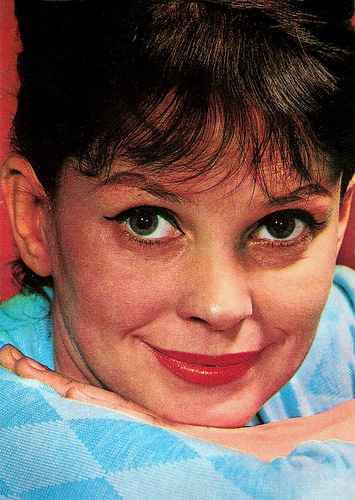
East-German postcard by VEB Progress Filmvertrieb, Berlin, no. 2256, 1965. Photo: Schwarzer.
Sources: Ines Walk (FilmZeit.de – German), DEFA Sternstunden (German), Wikipedia (German) and .

East-German postcard by VEB Progress Filmvertrieb, Berlin, no. 1368. Photo: DEFA / Neufeld.
Cold War years
Doris Abesser was born in Berlin in 1935. During her youth she discovered her passion for acting. At 16, she took her first acting classes and trained at the Drama School of the Deutsches Theater in Berlin.
In 1956, she made her stage debut at the Theater der Bergarbeiter in Senftenberg, where she worked for three years. In 1959, she moved to the Dresden State Theatre and two years later she went to play at the Volksbühne in Berlin.
During the Cold War years, she was used several times in anti-capitalist film productions of the former GDR. Her film debut was in the DEFA production Zwischenfall in Benderath/Incident in Benderath (János Veiczi, 1956) with Uwe-Jens Pape.
She appeared with Gisela May in the drama Eine alte Liebe/An old love (Frank Beyer, 1959). In Das Leben beginnt/Life Begins (Heiner Carow, 1959) she fled to the West and later came back disappointed. In Septemberliebe/September Love (Kurt Maetzig, 1960) she held her friend (Ulrich Thein) from such a flight.

East-German postcard by VEB Progress Filmvertrieb, Berlin, no. 1746, 1963. Photo: Thomas Klamann.

East-German postcard by VEB Progress Filmvertrieb, Berlin, no. 2115, 1964. Photo: Ludwig Schirmer.
The Witch of the West
In 1961, Doris Abesser was chosen as ´Filmliebling des Jahres 1961´ (Favourite Film Star of 1961) by the youth magazine Neues Leben, and she won 1961 the Erich-Weinert-Medaille (an art award of the FDJ - the official socialist youth movement of the GDR).
A success was the drama Professor Mamlock (Konrad Wolf, 1961), in which she played the Jewish Ruth Mamlock, the professor’s daughter.
Then she played in the DEFA film Der Frühling braucht Zeit/Spring takes time (1965), directed by her husband Günter Stahnke. The film investigates the causes of an industrial accident. To blame are amongst others the lack of competence and the inefficient operation of the enterprise, the distrust of non-party specialists. The socio-critical production was banned shortly after its premiere.
After this, the DEFA offered her no more lead roles in the studio’s productions. Years later, the film won two awards at the Berlin Film Festival 1990.
Abesser played in the theatre, such as at the Friedrich-Wolf-Theater in Neustrelitz, where she starred as Eliza Dolittle in the musical My Fair Lady and as the Witch of the West in The Wizzard of Oz. From 1968 to 1997 she was a member of the Metropol Theater in Berlin.
Since the 1990s, she performed in literary and musical programs on stage and on the radio. She also works for television, and guest starred in the crime series Polizeiruf 110 (1977, 1989, 1995), Tatort (2001) and SOKO Leipzig (2005). She also played the lead in the series Geschichten übern Gartenzaun/Stories over the garden fence (1982–1985).
Doris Abesser was married to the German director Günter Stahnke, but they divorced. The couple has a son, Robert (1963). Doris Abesser lives in Berlin.

East-German postcard by VEB Progress Filmvertrieb, Berlin, no. 1329 F, 1960. Photo: Kurt Wunsch.

East-German postcard by VEB Progress Filmvertrieb, Berlin, no. 2256, 1965. Photo: Schwarzer.
Sources: Ines Walk (FilmZeit.de – German), DEFA Sternstunden (German), Wikipedia (German) and .
Published on April 04, 2015 22:00
April 3, 2015
De Jantjes (1934)
The musical drama De Jantjes (Jaap Speyer, 1934) is a little pre-war Dutch gem. It was the second Dutch sound film and a huge box office hit at the time. The film was based on a popular play by Herman Bouber and one of the leads was played by his wife, character actress Aaf Bouber.
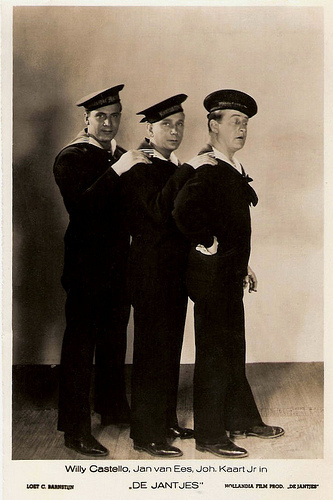
Dutch postcard by Hollandia Film Prod. / Loet C. Barnstijn. Photo: publicity still for De Jantjes (1934).
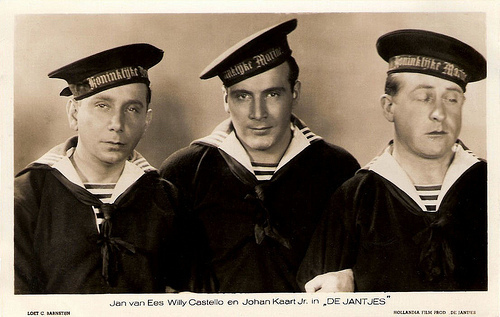
Dutch postcard by Hollandia Film Prod. / Loet C. Barnstijn. Photo: publicity still for De Jantjes (1934).
Jordaan Play
De Jantjes (the international title is The Tars) was based on a popular 'Jordaan play' (a play set in an old neighbourhood of Amsterdam, the Jordaan) by Herman Bouber.
The music of the songs was written by Louis Davids. The musical was performed for the first time in 1920 with Louis Davids and his wife Margie Morris in the principal parts. The musical is one of the classics of the Dutch entertainment world.
De Jantjes had already been adapted as a silent film in 1922 starring Louis Davids. In 1933 director Jaap Speyer, who had made many silent films in Germany, started to shoot a new sound version.
There was even a competition which film would be the first Dutch sound film in the cinema. The other competitor, Willem van Oranje/Willem of Orange (Jan Teunissen, 1934) won, but lost at the box office, and got the worst reviews.
De Jantjes/The Tars (Jaap Speyer, 1934) has nice camera work by Henk Alsem and Akos Farkas and a couple of classic Dutch songs. The cast is excellent including popular revue and film stars as Fien de la Mar , Cissy van Bennekom , Sylvain Poons , Heintje Davids and her brother Louis Davids, and Aaf Bouber , the wife of the author.
The title characters are three sailors, played by Jan van Ees , Willy Castello and Johan Kaart jr. , who return from the Dutch Indies to their old neighbourhood. There they meet love and labour problems.
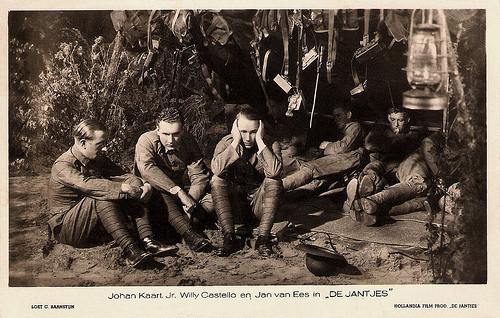
Dutch postcard by M. B. & Z. (M. Bonnist & Zonen, Amsterdam) for Hollandia Film Prod. / Loet C. Barnstijn. Photo: publicity still for De Jantjes (1934).
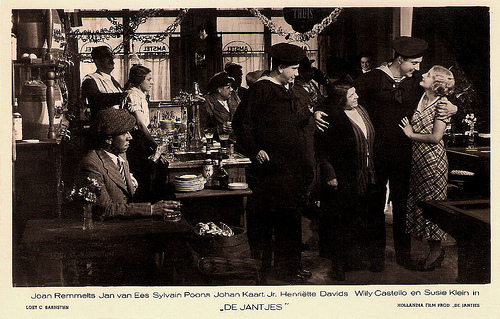
Dutch postcard by Hollandia Film Prod. / Loet C. Barnstijn. Photo: publicity still for De Jantjes (1934).
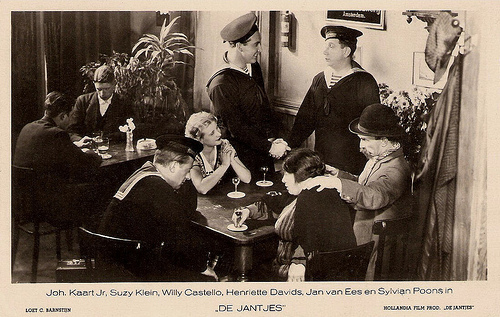
Dutch postcard by Hollandia Film Prod. / Loet C. Barnstijn. Photo: publicity still for De Jantjes (1934).
Aaf Bouber
Aaf Bouber (1885-1974), the wife of author Herman Bouber, played the central role of Aunt Piet in De Jantjes/The Tars (1934). She acted in several Dutch films from the 1910s into the 1950s.
As a child she was already loving the stage and performed at parties and markets in her hometown Hoorn. When she was sixteen she left home for Amsterdam and was engaged for the variety show Amsterdam starring Louisette and Chrétienne in grand theatre Carré.
In the following years she worked with such Dutch stage legends as Willem Hart and Louis Bouwmeester . She also acted in silent films like Fatum (Theo Frenkel sr., 1914) with Louis Bouwmeester , the fisher drama Het wrak in de Noordzee (Theo Frenkel sr., 1915) and Genie tegen geweld (Theo Frenkel sr., 1916).
Then she met Herman Bouber, director of the Plantage Theatre. He helped her to develop into an incomparable character actress in his popular folk plays like De Jantjes, Bleeke Bet and Oranje Hein all situated in the old Amsterdam neighbourhood De Jordaan.
She also played in the silent films Cirque Hollandais/Dutch Circus (Theo Frenkel Sr., 1924) starring Louis Bouwmeester , Oranje Hein/Orange Hein (Alex Benno, 1925) and Klassenstrijd/Class Struggle (Willy Mullens, 1928).
In the many performances through the years of De Jantjes, Aaf Bouber (often billed as Aaf Bouber-ten Hoope) would play all the female roles. After the surprising success of the sound film version of De Jantjes (Jaap Speyer, 1934) she would play the title character in another film based on a play by her husband, Bleeke Bet/Pale Beth (Richard Oswald, Alex Benno, 1934), which also became a big hit.
Other films of the 1930s include the fisher drama Op hoop van Zegen (Alex Benno, Louis Saalborn, 1934), De Suikerfreule (Haro van Peski, 1935), another adaptation of Oranje Hein (Max Nosseck, 1936), Drie wensen/Three Wishes (Kurt Gerron, 1937), the Daddy Longlengs adaptation Vadertje Langbeen (Friedrich Zelnik a.k.a. Frederic Zelnik, 1938) and Ergens in Nederland/Somewhere in the Netherlands (Ludwig Berger, 1940). The latter film was just ready for release when the Netherlands were conquered by the Nazis, who forbade its exhibition.
During the war she was seen in 7 maal 7/Seven Times Seven (Walter Smith a.o., 1942) and De laatste dagen van een eiland/The Final Days of an Island (Ernst Winar, 1942). After the war she made one more film, the comedy Sterren stralen overal/Stars Twinkle Everywhere (Gerard Rutten, 1953).
During her long career she would also play hundreds of roles on the stage, radio and television. When Aaf Bouber was 85 she played her last role in the TV thriller Ritueel/Ritual (1970). She passed away in 1974.
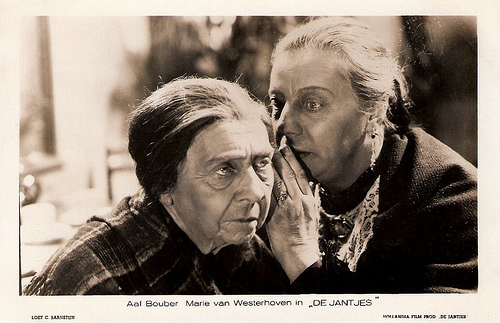
Dutch postcard. Photo: Loet C. Barnstijn / Hollandia Film Prod. Aaf Bouber is seen on the left with at right Marie van Westerhoven as the gossip Betje.
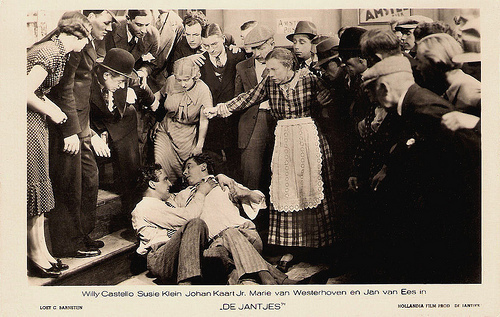
Dutch postcard by Hollandia Film Prod. / Loet C. Barnstijn. Photo: publicity still for De Jantjes (1934).
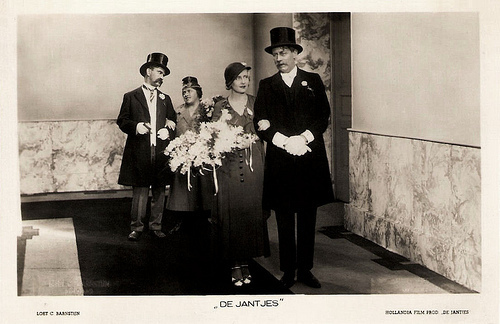
Dutch postcard. Photo: Loet C. Barnstijn / Hollandia Film Prod.
Sources: De Boubers (Dutch), Wikipedia (Dutch), and IMDb.

Dutch postcard by Hollandia Film Prod. / Loet C. Barnstijn. Photo: publicity still for De Jantjes (1934).

Dutch postcard by Hollandia Film Prod. / Loet C. Barnstijn. Photo: publicity still for De Jantjes (1934).
Jordaan Play
De Jantjes (the international title is The Tars) was based on a popular 'Jordaan play' (a play set in an old neighbourhood of Amsterdam, the Jordaan) by Herman Bouber.
The music of the songs was written by Louis Davids. The musical was performed for the first time in 1920 with Louis Davids and his wife Margie Morris in the principal parts. The musical is one of the classics of the Dutch entertainment world.
De Jantjes had already been adapted as a silent film in 1922 starring Louis Davids. In 1933 director Jaap Speyer, who had made many silent films in Germany, started to shoot a new sound version.
There was even a competition which film would be the first Dutch sound film in the cinema. The other competitor, Willem van Oranje/Willem of Orange (Jan Teunissen, 1934) won, but lost at the box office, and got the worst reviews.
De Jantjes/The Tars (Jaap Speyer, 1934) has nice camera work by Henk Alsem and Akos Farkas and a couple of classic Dutch songs. The cast is excellent including popular revue and film stars as Fien de la Mar , Cissy van Bennekom , Sylvain Poons , Heintje Davids and her brother Louis Davids, and Aaf Bouber , the wife of the author.
The title characters are three sailors, played by Jan van Ees , Willy Castello and Johan Kaart jr. , who return from the Dutch Indies to their old neighbourhood. There they meet love and labour problems.

Dutch postcard by M. B. & Z. (M. Bonnist & Zonen, Amsterdam) for Hollandia Film Prod. / Loet C. Barnstijn. Photo: publicity still for De Jantjes (1934).

Dutch postcard by Hollandia Film Prod. / Loet C. Barnstijn. Photo: publicity still for De Jantjes (1934).

Dutch postcard by Hollandia Film Prod. / Loet C. Barnstijn. Photo: publicity still for De Jantjes (1934).
Aaf Bouber
Aaf Bouber (1885-1974), the wife of author Herman Bouber, played the central role of Aunt Piet in De Jantjes/The Tars (1934). She acted in several Dutch films from the 1910s into the 1950s.
As a child she was already loving the stage and performed at parties and markets in her hometown Hoorn. When she was sixteen she left home for Amsterdam and was engaged for the variety show Amsterdam starring Louisette and Chrétienne in grand theatre Carré.
In the following years she worked with such Dutch stage legends as Willem Hart and Louis Bouwmeester . She also acted in silent films like Fatum (Theo Frenkel sr., 1914) with Louis Bouwmeester , the fisher drama Het wrak in de Noordzee (Theo Frenkel sr., 1915) and Genie tegen geweld (Theo Frenkel sr., 1916).
Then she met Herman Bouber, director of the Plantage Theatre. He helped her to develop into an incomparable character actress in his popular folk plays like De Jantjes, Bleeke Bet and Oranje Hein all situated in the old Amsterdam neighbourhood De Jordaan.
She also played in the silent films Cirque Hollandais/Dutch Circus (Theo Frenkel Sr., 1924) starring Louis Bouwmeester , Oranje Hein/Orange Hein (Alex Benno, 1925) and Klassenstrijd/Class Struggle (Willy Mullens, 1928).
In the many performances through the years of De Jantjes, Aaf Bouber (often billed as Aaf Bouber-ten Hoope) would play all the female roles. After the surprising success of the sound film version of De Jantjes (Jaap Speyer, 1934) she would play the title character in another film based on a play by her husband, Bleeke Bet/Pale Beth (Richard Oswald, Alex Benno, 1934), which also became a big hit.
Other films of the 1930s include the fisher drama Op hoop van Zegen (Alex Benno, Louis Saalborn, 1934), De Suikerfreule (Haro van Peski, 1935), another adaptation of Oranje Hein (Max Nosseck, 1936), Drie wensen/Three Wishes (Kurt Gerron, 1937), the Daddy Longlengs adaptation Vadertje Langbeen (Friedrich Zelnik a.k.a. Frederic Zelnik, 1938) and Ergens in Nederland/Somewhere in the Netherlands (Ludwig Berger, 1940). The latter film was just ready for release when the Netherlands were conquered by the Nazis, who forbade its exhibition.
During the war she was seen in 7 maal 7/Seven Times Seven (Walter Smith a.o., 1942) and De laatste dagen van een eiland/The Final Days of an Island (Ernst Winar, 1942). After the war she made one more film, the comedy Sterren stralen overal/Stars Twinkle Everywhere (Gerard Rutten, 1953).
During her long career she would also play hundreds of roles on the stage, radio and television. When Aaf Bouber was 85 she played her last role in the TV thriller Ritueel/Ritual (1970). She passed away in 1974.

Dutch postcard. Photo: Loet C. Barnstijn / Hollandia Film Prod. Aaf Bouber is seen on the left with at right Marie van Westerhoven as the gossip Betje.

Dutch postcard by Hollandia Film Prod. / Loet C. Barnstijn. Photo: publicity still for De Jantjes (1934).

Dutch postcard. Photo: Loet C. Barnstijn / Hollandia Film Prod.
Sources: De Boubers (Dutch), Wikipedia (Dutch), and IMDb.
Published on April 03, 2015 22:00
April 2, 2015
Dalila Di Lazzaro
Beautiful Dalila Di Lazzaro (1953) is an Italian model, actress and writer. Between the mid-1970s and the early 1980s she appeared in notable films by such directors as Alberto Lattuada, Luigi Comencini, Dario Argento, and Jacques Deray.
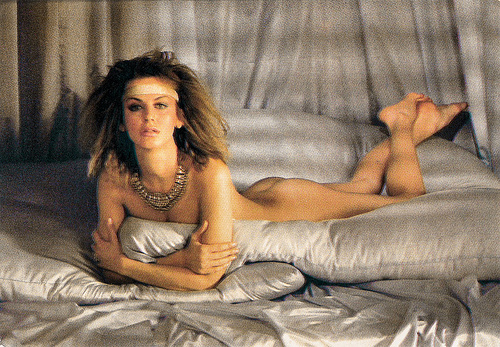
Italian postcard by Playboy Edizione Italiana, no. 2. Photo: Fabrizio Livio.
Andy Warhol
Dalila Di Lazzaro was born in Udine in the Po valley in 1953. Her father Attilio was a former heavy-weight and artisan and her mother Rosalia was a seamstress. Her youth was difficult and reportedly she was raped several times, since she was only 5 years old.
At 16, she ran away from home with her fiancé Franco Cosetta. They had a child, Christian, born in 1969. She started to work as a fashion model and a few weeks later, she was already on the cover of Vogue magazine. In time, she became the subject of famous photographers such as Andy Warhol.
Soon the Italian film industry also spotted her. Credited as Dalila Di Lamar, she made her debut in the Spaghetti Western Si può fare... amigo/It Can Be Done Amigo (Maurizio Lucidi, 1972) starring Bud Spencer and Jack Palance.
She had her first female lead – now credited as Dalila Parker - in the horror film Frankenstein 80 (Mario Mancini, 1972) starring bodybuilder Gordon Mitchell as the mad doctor. Fred Beldin at AllMovie : “Frankenstein '80 is stupid, sickening, and obscene, but seekers of psychotronic cinema will have a field day with this ridiculous Italian exploitation product. Despite a repetitious pace and poor cinematography (which sometimes renders the action incomprehensible), Frankenstein '80 never gets boring and manages to outrage consistently throughout its screen time.”
Di Lazzaro was the only female cast member who was not stripped and disembowelled, but that did happen to her the next year in Flesh for Frankenstein/Andy Warhol's Frankenstein (Paul Morrissey, 1973). In this Italian-French horror film produced by Andy Warhol, Andrew Braunsberg, Louis Peraino and Carlo Ponti, Di Lazzaro played the female monster. Udo Kier portrayed Baron Frankenstein, Monique van Vooren his wife and Joe Dallessandro was the hunky stable boy Nicholas.
Carlo Ponti wanted to make star out of Di Lazzaro and she appeared next in two other Ponti productions, the comedies Il bestione/The Beast (Sergio Corbucci, 1973) with Michel Constantin and Giancarlo Giannini, and La pupa del gangster/Sex Pot (Giorgio Capitani, 1975) with Sophia Loren and Marcello Mastroianni . During the shooting of this film the tabloid press went wild about the supposed rivalry between Di Lazzaro and the older Sophia Loren , who was married to Ponti.
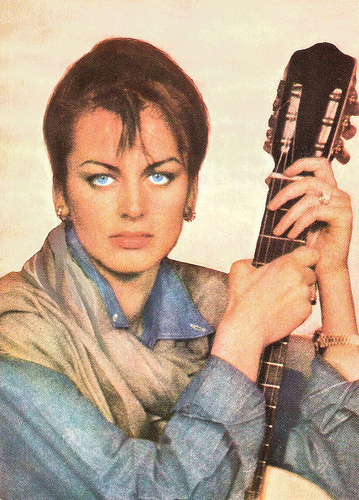
Romanian postcard by Casa Filmului Acin.

Romanian postcard by Casa Filmului Acin.
Dario Argento
Between the mid-1970s and the early 1980s Di Lazzaro worked in some interesting films with notable directors. Carlo Ponti helped her to get the title role in Alberto Lattuada’s comedy-drama Oh, Serafina! (1976). It was her breakthrough.
She appeared in two films by Luigi Comencini, first opposite Ugo Tognazzi and Mariangela Melato in the giallo-comedy Il gatto/The Cat (Luigi Comencini, 1977), and then in the drama Voltati Eugenio/Eugenio (Luigi Comencini, 1980) with Bernard Blier. In France, she starred opposite Alain Delon in Jacques Deray’s crime film Trois hommes à abattre/Three Men to Kill (1980). It was a huge box office hit.
Another success was Dario Argento’s horror film Phenomena/Creepers (1985), starring 14-year-old Jennifer Connelly as a sleepwalker who has a bizarre telepathic bond with insects. She uses them to pursue a serial killer who is butchering young women at and around her school. Di Lazzaro played the head mistress.
In 1983 she refused the role of Domino, later played by Kim Basinger, in the James Bond film Never Say Never Again (Irvin Kershner, 1983). From the mid 1980s on, she focused primarily on television. TV series with her include Aeroporto internazionale/International Airport (1985) with Aldolfo Celi, and the romantic miniseries Disperatamente Giulia/Julia Forever (Enrico Maria Salerno, 1989) with Tahnee Welch and Fabio Testi.
Her later feature films include the drama Diceria dell'untore/The Plague Sowers (Beppe Cino, 1990) with Franco Nero , and the action film Power Force (Godfrey Ho, 1991). In 1991, her 22-year-old son Christian died in a road accident. Di Lazzaro was devastated and suffered a stroke. She retired for some time from public life and from 2006 on, she wrote five books, dedicated to her son.
In 1997 she played in the drama Un bel dì vedremo/One beautiful day (Tonino Valerii, 1997) with Giuliano Gemma . Her last film appearance was in the comedy-drama L'Ultima ruota del carro/The Fifth Wheel (Giovanni Veronesi, 2013), and her most recent TV role was in the Miniseries Rodolfo Valentino - La leggenda/Rudolph Valentino – the Legend (Alessio Inturri, 2013) featuring Gabriel Garko as the silent film idol. Dalila Di Lazzaro lives with her family at the Cote d’Azur and in Milan.
Digital restoration of rare trailer for Flesh for Frankenstein/Andy Warhol's Frankenstein (1973). Source: Pendulum House (YouTube).
Trailer for Trois hommes à abattre/Three Men to Kill (1980). Source: Zerone190 (YouTube).
Trailer for Phenomena/Creepers (1985). Source: Massacre SlutDoom (YouTube).
Sources: Fred Beldin (AllMovie), Celine Colassin (D’autres étoiles vilantes – French), Corriere della Sera (Italian), Wikipedia and .

Italian postcard by Playboy Edizione Italiana, no. 2. Photo: Fabrizio Livio.
Andy Warhol
Dalila Di Lazzaro was born in Udine in the Po valley in 1953. Her father Attilio was a former heavy-weight and artisan and her mother Rosalia was a seamstress. Her youth was difficult and reportedly she was raped several times, since she was only 5 years old.
At 16, she ran away from home with her fiancé Franco Cosetta. They had a child, Christian, born in 1969. She started to work as a fashion model and a few weeks later, she was already on the cover of Vogue magazine. In time, she became the subject of famous photographers such as Andy Warhol.
Soon the Italian film industry also spotted her. Credited as Dalila Di Lamar, she made her debut in the Spaghetti Western Si può fare... amigo/It Can Be Done Amigo (Maurizio Lucidi, 1972) starring Bud Spencer and Jack Palance.
She had her first female lead – now credited as Dalila Parker - in the horror film Frankenstein 80 (Mario Mancini, 1972) starring bodybuilder Gordon Mitchell as the mad doctor. Fred Beldin at AllMovie : “Frankenstein '80 is stupid, sickening, and obscene, but seekers of psychotronic cinema will have a field day with this ridiculous Italian exploitation product. Despite a repetitious pace and poor cinematography (which sometimes renders the action incomprehensible), Frankenstein '80 never gets boring and manages to outrage consistently throughout its screen time.”
Di Lazzaro was the only female cast member who was not stripped and disembowelled, but that did happen to her the next year in Flesh for Frankenstein/Andy Warhol's Frankenstein (Paul Morrissey, 1973). In this Italian-French horror film produced by Andy Warhol, Andrew Braunsberg, Louis Peraino and Carlo Ponti, Di Lazzaro played the female monster. Udo Kier portrayed Baron Frankenstein, Monique van Vooren his wife and Joe Dallessandro was the hunky stable boy Nicholas.
Carlo Ponti wanted to make star out of Di Lazzaro and she appeared next in two other Ponti productions, the comedies Il bestione/The Beast (Sergio Corbucci, 1973) with Michel Constantin and Giancarlo Giannini, and La pupa del gangster/Sex Pot (Giorgio Capitani, 1975) with Sophia Loren and Marcello Mastroianni . During the shooting of this film the tabloid press went wild about the supposed rivalry between Di Lazzaro and the older Sophia Loren , who was married to Ponti.

Romanian postcard by Casa Filmului Acin.

Romanian postcard by Casa Filmului Acin.
Dario Argento
Between the mid-1970s and the early 1980s Di Lazzaro worked in some interesting films with notable directors. Carlo Ponti helped her to get the title role in Alberto Lattuada’s comedy-drama Oh, Serafina! (1976). It was her breakthrough.
She appeared in two films by Luigi Comencini, first opposite Ugo Tognazzi and Mariangela Melato in the giallo-comedy Il gatto/The Cat (Luigi Comencini, 1977), and then in the drama Voltati Eugenio/Eugenio (Luigi Comencini, 1980) with Bernard Blier. In France, she starred opposite Alain Delon in Jacques Deray’s crime film Trois hommes à abattre/Three Men to Kill (1980). It was a huge box office hit.
Another success was Dario Argento’s horror film Phenomena/Creepers (1985), starring 14-year-old Jennifer Connelly as a sleepwalker who has a bizarre telepathic bond with insects. She uses them to pursue a serial killer who is butchering young women at and around her school. Di Lazzaro played the head mistress.
In 1983 she refused the role of Domino, later played by Kim Basinger, in the James Bond film Never Say Never Again (Irvin Kershner, 1983). From the mid 1980s on, she focused primarily on television. TV series with her include Aeroporto internazionale/International Airport (1985) with Aldolfo Celi, and the romantic miniseries Disperatamente Giulia/Julia Forever (Enrico Maria Salerno, 1989) with Tahnee Welch and Fabio Testi.
Her later feature films include the drama Diceria dell'untore/The Plague Sowers (Beppe Cino, 1990) with Franco Nero , and the action film Power Force (Godfrey Ho, 1991). In 1991, her 22-year-old son Christian died in a road accident. Di Lazzaro was devastated and suffered a stroke. She retired for some time from public life and from 2006 on, she wrote five books, dedicated to her son.
In 1997 she played in the drama Un bel dì vedremo/One beautiful day (Tonino Valerii, 1997) with Giuliano Gemma . Her last film appearance was in the comedy-drama L'Ultima ruota del carro/The Fifth Wheel (Giovanni Veronesi, 2013), and her most recent TV role was in the Miniseries Rodolfo Valentino - La leggenda/Rudolph Valentino – the Legend (Alessio Inturri, 2013) featuring Gabriel Garko as the silent film idol. Dalila Di Lazzaro lives with her family at the Cote d’Azur and in Milan.
Digital restoration of rare trailer for Flesh for Frankenstein/Andy Warhol's Frankenstein (1973). Source: Pendulum House (YouTube).
Trailer for Trois hommes à abattre/Three Men to Kill (1980). Source: Zerone190 (YouTube).
Trailer for Phenomena/Creepers (1985). Source: Massacre SlutDoom (YouTube).
Sources: Fred Beldin (AllMovie), Celine Colassin (D’autres étoiles vilantes – French), Corriere della Sera (Italian), Wikipedia and .
Published on April 02, 2015 22:00
April 1, 2015
Phyllis Dare
English singer and actress Phyllis Dare (1890-1975) was famous for her performances in Edwardian musical comedy and other musical theatre in the first half of the 20th century. She appeared occasionally in films and was one of the leading Picture Postcard beauties of the Belle Epoque.
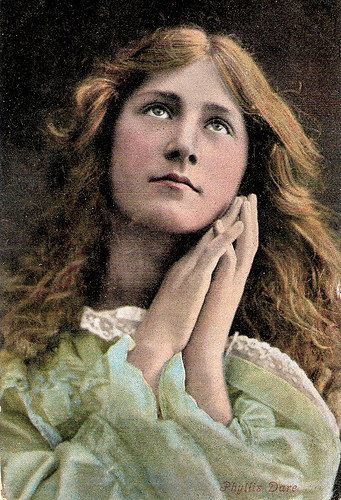
British postcard in the Valentine's Series. Photo: Foulsham & Banfield.
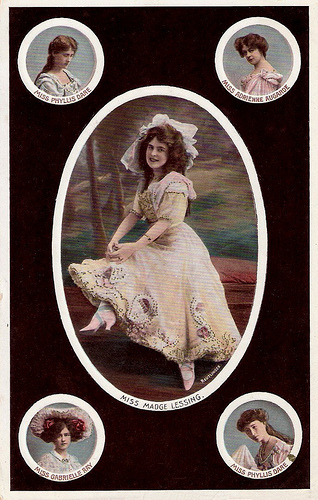
British postcard by H. Vertigen & Co., London, Series no. 6204. In the centre: Madge Lessing. From left under with the clock: Gabrielle Ray, Phyllis Dare, Adrienne Augarde and again Phyllis Dare.
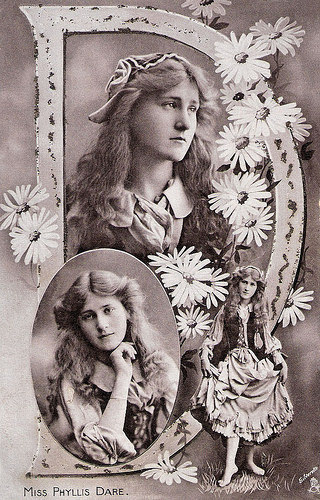
British postcard by Tuck's in the Silverette series, no. P 318.
Leading Picture Postcard Beauties
Phyllis Dare was born Phyllis Constance Haddie Dones in Chelsea, London, in 1890. Her father, Arthur Albert Dones, was a divorce clerk, and her mother was Harriette Amelia Wheeler. Dare was the youngest of three children. Her sister, Zena , three and a half years her senior, also became a well-known musical comedy actress. They had a brother named Jack.
Phyllis first performed on stage at the age of nine, in the Christmas pantomime Babes in the Wood (1899) at the Coronet Theatre in London. Her sister Zena was also cast in this production, and they both adopted the surname of Dare. Both soon became leading Picture Postcard Beauties at the turn of last century.
Phyllis appeared as Little Christina in Ib and Little Christina (1900) at the Prince of Wales's Theatre. She played Mab in the Seymour Hicks musical Bluebell in Fairyland (1901), featuring Hicks himself as Dicky and his actress wife Ellaline Terris as Bluebell.
At the age of 15, she took over the starring role of Angela in The Catch of the Season (1905). She travelled to a convent in the Belgian Ardennes to continue her studies. A rumour circulated that her sudden departure was a result of a pregnancy. In any event, she returned to London with her father in haste in 1906. On short notice she had to take over the title role of Julia Chaldicott, in Leslie Stuart's The Belle of Mayfair when American star Edna May left the cast. Just 16 years old, the role established her as a major performer in London.
In 1909, Dare created the role of Eileen Cavanagh in the hit musical The Arcadians, which played for 809 performances, and Dare stayed for the entire run. The musical marked the beginning of Dare's association with producer George Edwardes, and she went on to star in several more of his productions in the next three years, including The Girl in the Train (1910), Peggy (1911), The Quaker Girl in Paris (1911) and The Sunshine Girl (1912–13). In 1913 she joined the cast of The Dancing Mistress.
Occasionally, she appeared in films. During the 1910s, she starred in the Hepworth production The Argentine Tango and Other Dances (1913) and Dr. Wake's Patient (Fred Paul, 1916). In the first, she danced two drawing-room dances with George Grossmith: the Bunny Hug and the Spanish Tango.
Dare began to develop a relationship with the composer Paul Rubens. He had written the music for The Sunshine Girl, and they became acquainted. He would write the music for her next series of shows, including The Girl from Utah at the Adelphi (1913), Miss Hook of Holland (1914) and Tina (1915). He also dedicated his most famous song, ‘I Love the Moon’ to her. During the run of Tina, Dare became engaged to Rubens. Their engagement ended when Rubens became very ill with consumption. He died in 1917 at the age of 41.
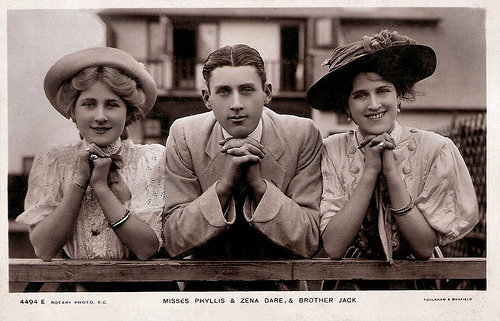
Phyllis, Jack and Zena Dare . British postcard by Rotary Photo, no. 4494 E. Photo: Foulsham & Banfield.
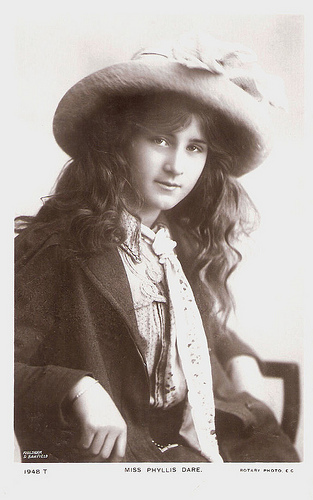
British postcard by Rotary Photo in the Rotary Photographic Series, no. 1948 T. Photo: Foulsham & Banfield.
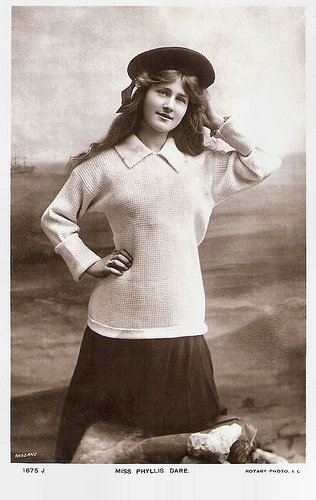
British postcard by Rotary Photo in the Rotary Photographic Series, no. 1875 J. Photo: Bassano. Sent by mail in 1913.
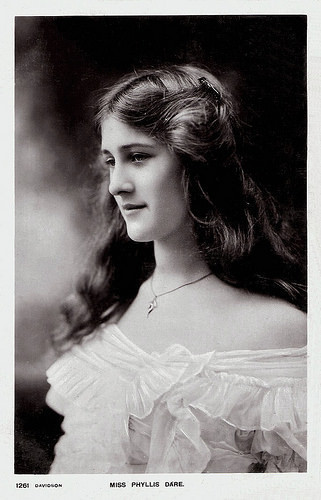
British postcard by Davidson Bros. in the Glossyphoto Series, no. 1261.
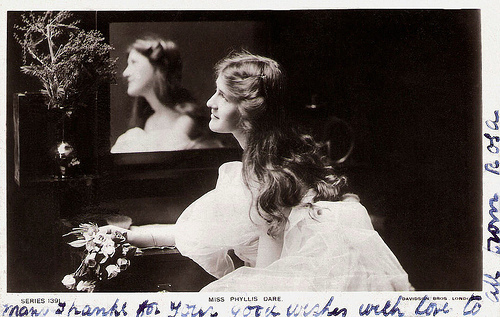
British postcard by Davidson Bros. in the Glossyphoto series, no. 1391. Sent by mail in 1908.
Moving with the time
Phyllis Dare continued to star in successful stage productions throughout the 1920s, such as in The Lady of the Rose (1922) and The Street Singer (1924). As fashions changed, she moved with the time.
Later at nearly 40, Dare turned to straight theatre plays. These included Aren't We All (1929), Words and Music (1932) and The Fugitives (1936).
She also appeared in a number of films, including the American drama The Common Law (George Archainbaud, 1923), the classic British crime film Crime on the Hill (Bernard Vorhaus, 1933), the drama Debt of Honour (Norman Walker, 1936) starring Leslie Banks, the drama Marigold (Thomas Bentley, 1938) and the comedy Gildersleeve on Broadway (Gordon Douglas, 1943).
In 1940, for the first time in over four decades, Phyllis and Zena Dare shared the stage, in a tour of Ivor Novello ’s Full House. In 1941–42, she was Juliet Maddock in Other People's Houses, and in 1946 she played the Marchioness of Mereston in Lady Frederick.
In 1949, Dare opened as Marta the mistress in Ivor Novello 's musical, King's Rhapsody, again with her sister Zena. Nearly eighteen months later Novello died while the play was still running, and at the end of seven more months, in October 1951, it closed. It was Dare's last theatrical endeavour.
At the age of 61, she retired to Brighton in 1951. In 1975, Phyllis Dare died in Brighton at the age of 84. Her sister Zena had died only six weeks earlier.
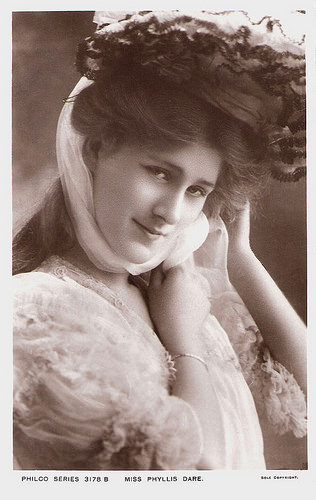
British postcard by in the Philco Series, no. 3178 B.
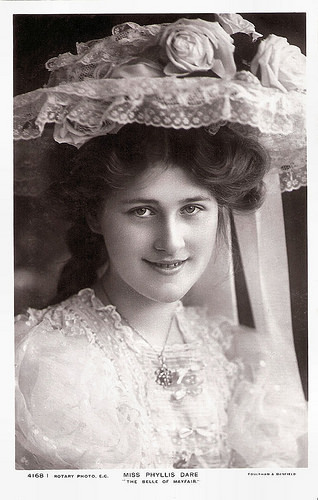
British postcard by Rotary, no. 4168 I. Photo: Foulsham & Banfield. Publicity still for the stage play The Belle of Mayfair (1906).
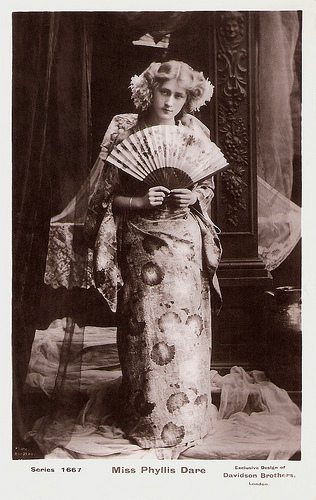
British postcard by Davidson Bros. in the Real Photographic Series, no. 1667.
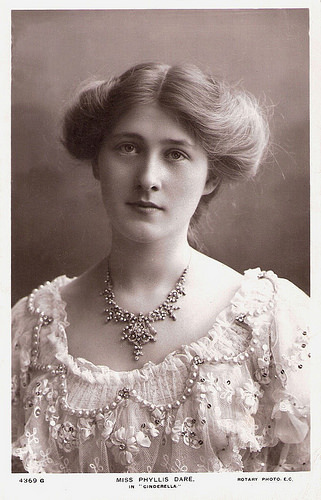
British postcard by Rotary, no. 4369 G. Photo: publicity still for the stage pantomime Cinderella (1907).
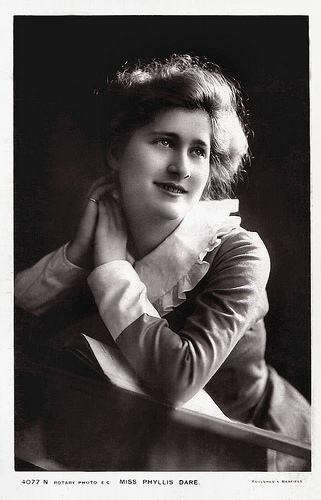
British postcard by Rotary Photo in the Rotary Photographic Series, no. 4077 N. Photo: Foulsham & Banfield.
Sources: Alan Courtney (Stage Beauty), Thomas Staedeli (Cyranos), National Portrait Gallery, Wikipedia and .

British postcard in the Valentine's Series. Photo: Foulsham & Banfield.

British postcard by H. Vertigen & Co., London, Series no. 6204. In the centre: Madge Lessing. From left under with the clock: Gabrielle Ray, Phyllis Dare, Adrienne Augarde and again Phyllis Dare.

British postcard by Tuck's in the Silverette series, no. P 318.
Leading Picture Postcard Beauties
Phyllis Dare was born Phyllis Constance Haddie Dones in Chelsea, London, in 1890. Her father, Arthur Albert Dones, was a divorce clerk, and her mother was Harriette Amelia Wheeler. Dare was the youngest of three children. Her sister, Zena , three and a half years her senior, also became a well-known musical comedy actress. They had a brother named Jack.
Phyllis first performed on stage at the age of nine, in the Christmas pantomime Babes in the Wood (1899) at the Coronet Theatre in London. Her sister Zena was also cast in this production, and they both adopted the surname of Dare. Both soon became leading Picture Postcard Beauties at the turn of last century.
Phyllis appeared as Little Christina in Ib and Little Christina (1900) at the Prince of Wales's Theatre. She played Mab in the Seymour Hicks musical Bluebell in Fairyland (1901), featuring Hicks himself as Dicky and his actress wife Ellaline Terris as Bluebell.
At the age of 15, she took over the starring role of Angela in The Catch of the Season (1905). She travelled to a convent in the Belgian Ardennes to continue her studies. A rumour circulated that her sudden departure was a result of a pregnancy. In any event, she returned to London with her father in haste in 1906. On short notice she had to take over the title role of Julia Chaldicott, in Leslie Stuart's The Belle of Mayfair when American star Edna May left the cast. Just 16 years old, the role established her as a major performer in London.
In 1909, Dare created the role of Eileen Cavanagh in the hit musical The Arcadians, which played for 809 performances, and Dare stayed for the entire run. The musical marked the beginning of Dare's association with producer George Edwardes, and she went on to star in several more of his productions in the next three years, including The Girl in the Train (1910), Peggy (1911), The Quaker Girl in Paris (1911) and The Sunshine Girl (1912–13). In 1913 she joined the cast of The Dancing Mistress.
Occasionally, she appeared in films. During the 1910s, she starred in the Hepworth production The Argentine Tango and Other Dances (1913) and Dr. Wake's Patient (Fred Paul, 1916). In the first, she danced two drawing-room dances with George Grossmith: the Bunny Hug and the Spanish Tango.
Dare began to develop a relationship with the composer Paul Rubens. He had written the music for The Sunshine Girl, and they became acquainted. He would write the music for her next series of shows, including The Girl from Utah at the Adelphi (1913), Miss Hook of Holland (1914) and Tina (1915). He also dedicated his most famous song, ‘I Love the Moon’ to her. During the run of Tina, Dare became engaged to Rubens. Their engagement ended when Rubens became very ill with consumption. He died in 1917 at the age of 41.

Phyllis, Jack and Zena Dare . British postcard by Rotary Photo, no. 4494 E. Photo: Foulsham & Banfield.

British postcard by Rotary Photo in the Rotary Photographic Series, no. 1948 T. Photo: Foulsham & Banfield.

British postcard by Rotary Photo in the Rotary Photographic Series, no. 1875 J. Photo: Bassano. Sent by mail in 1913.

British postcard by Davidson Bros. in the Glossyphoto Series, no. 1261.

British postcard by Davidson Bros. in the Glossyphoto series, no. 1391. Sent by mail in 1908.
Moving with the time
Phyllis Dare continued to star in successful stage productions throughout the 1920s, such as in The Lady of the Rose (1922) and The Street Singer (1924). As fashions changed, she moved with the time.
Later at nearly 40, Dare turned to straight theatre plays. These included Aren't We All (1929), Words and Music (1932) and The Fugitives (1936).
She also appeared in a number of films, including the American drama The Common Law (George Archainbaud, 1923), the classic British crime film Crime on the Hill (Bernard Vorhaus, 1933), the drama Debt of Honour (Norman Walker, 1936) starring Leslie Banks, the drama Marigold (Thomas Bentley, 1938) and the comedy Gildersleeve on Broadway (Gordon Douglas, 1943).
In 1940, for the first time in over four decades, Phyllis and Zena Dare shared the stage, in a tour of Ivor Novello ’s Full House. In 1941–42, she was Juliet Maddock in Other People's Houses, and in 1946 she played the Marchioness of Mereston in Lady Frederick.
In 1949, Dare opened as Marta the mistress in Ivor Novello 's musical, King's Rhapsody, again with her sister Zena. Nearly eighteen months later Novello died while the play was still running, and at the end of seven more months, in October 1951, it closed. It was Dare's last theatrical endeavour.
At the age of 61, she retired to Brighton in 1951. In 1975, Phyllis Dare died in Brighton at the age of 84. Her sister Zena had died only six weeks earlier.

British postcard by in the Philco Series, no. 3178 B.

British postcard by Rotary, no. 4168 I. Photo: Foulsham & Banfield. Publicity still for the stage play The Belle of Mayfair (1906).

British postcard by Davidson Bros. in the Real Photographic Series, no. 1667.

British postcard by Rotary, no. 4369 G. Photo: publicity still for the stage pantomime Cinderella (1907).

British postcard by Rotary Photo in the Rotary Photographic Series, no. 4077 N. Photo: Foulsham & Banfield.
Sources: Alan Courtney (Stage Beauty), Thomas Staedeli (Cyranos), National Portrait Gallery, Wikipedia and .
Published on April 01, 2015 22:00
Paul van Yperen's Blog
- Paul van Yperen's profile
- 13 followers
Paul van Yperen isn't a Goodreads Author
(yet),
but they
do have a blog,
so here are some recent posts imported from
their feed.



